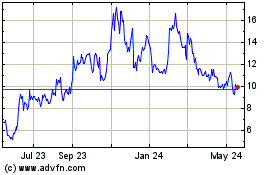0001750284false00017502842024-01-082024-01-08
UNITED STATES
SECURITIES AND EXCHANGE COMMISSION
WASHINGTON, D.C. 20549
FORM 8-K
CURRENT REPORT
Pursuant to Section 13 or 15(d) of the Securities Exchange Act of 1934
|
Date of Report (Date of earliest event reported): January 08, 2024 |
Olema Pharmaceuticals, Inc.
(Exact name of Registrant as Specified in Its Charter)
|
|
|
|
|
Delaware |
001-39712 |
30-0409740 |
(State or Other Jurisdiction
of Incorporation) |
(Commission File Number) |
(IRS Employer
Identification No.) |
|
|
|
|
|
780 Brannan Street |
|
San Francisco, California |
|
94103 |
(Address of Principal Executive Offices) |
|
(Zip Code) |
|
Registrant’s Telephone Number, Including Area Code: 415 651-3316 |
(Former Name or Former Address, if Changed Since Last Report)
Check the appropriate box below if the Form 8-K filing is intended to simultaneously satisfy the filing obligation of the registrant under any of the following provisions:
☐Written communications pursuant to Rule 425 under the Securities Act (17 CFR 230.425)
☐Soliciting material pursuant to Rule 14a-12 under the Exchange Act (17 CFR 240.14a-12)
☐Pre-commencement communications pursuant to Rule 14d-2(b) under the Exchange Act (17 CFR 240.14d-2(b))
☐Pre-commencement communications pursuant to Rule 13e-4(c) under the Exchange Act (17 CFR 240.13e-4(c))
Securities registered pursuant to Section 12(b) of the Act:
|
|
|
|
|
Title of each class
|
|
Trading
Symbol(s) |
|
Name of each exchange on which registered
|
Common Stock, par value $0.0001 per share |
|
OLMA |
|
The Nasdaq Global Select Market |
Indicate by check mark whether the registrant is an emerging growth company as defined in Rule 405 of the Securities Act of 1933 (§ 230.405 of this chapter) or Rule 12b-2 of the Securities Exchange Act of 1934 (§ 240.12b-2 of this chapter).
Emerging growth company ☐
If an emerging growth company, indicate by check mark if the registrant has elected not to use the extended transition period for complying with any new or revised financial accounting standards provided pursuant to Section 13(a) of the Exchange Act. ☐
Item 7.01 Regulation FD Disclosure.
On January 8, 2024, Olema Pharmaceuticals, Inc. (the “Company”) made available on its website a copy of the Company’s presentation to be shared with investors and others from time to time beginning on January 8, 2024. The presentation is being furnished as Exhibit 99.1 to this Current Report on Form 8-K.
The information in Exhibit 99.1 attached hereto is intended to be furnished and shall not be deemed “filed” for purposes of Section 18 of the Securities Exchange Act of 1934, as amended (the “Exchange Act”) or otherwise subject to the liabilities of that section, nor shall it be deemed incorporated by reference in any filing under the Securities Act of 1933, as amended or the Exchange Act, except as expressly set forth by specific reference in such filing.
Item 9.01 Financial Statements and Exhibits.
SIGNATURES
Pursuant to the requirements of the Securities Exchange Act of 1934, the registrant has duly caused this report to be signed on its behalf by the undersigned hereunto duly authorized.
|
|
|
|
|
|
|
Olema Pharmaceuticals, Inc. |
|
|
|
|
Date: |
Janaury 8, 2024 |
By: |
/s/ Shane Kovacs |
|
|
|
Shane Kovacs
Chief Operating and Financial Officer |

Olema Oncology �JP Morgan Conference January 2024
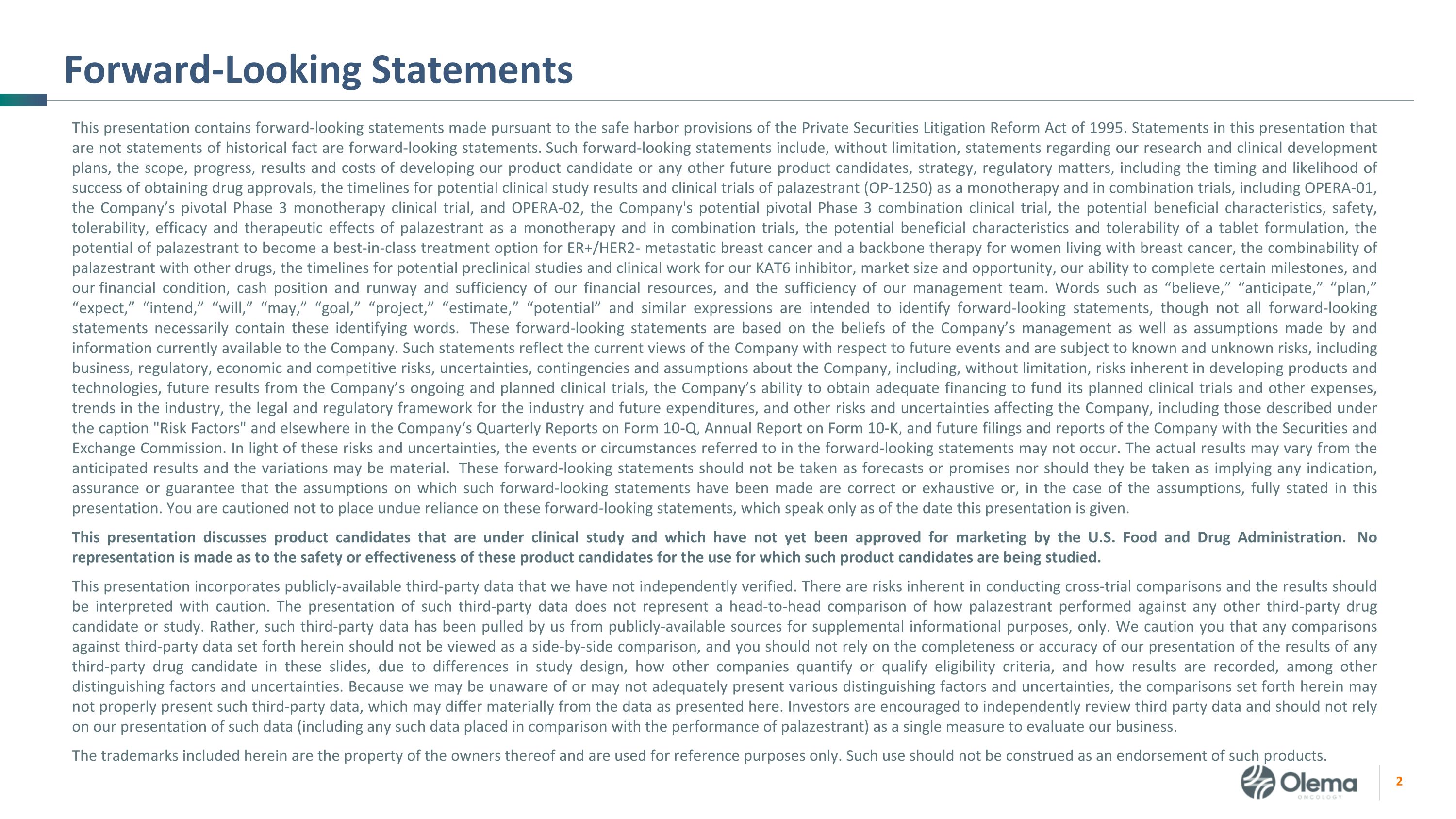
Forward-Looking Statements This presentation contains forward-looking statements made pursuant to the safe harbor provisions of the Private Securities Litigation Reform Act of 1995. Statements in this presentation that are not statements of historical fact are forward-looking statements. Such forward-looking statements include, without limitation, statements regarding our research and clinical development plans, the scope, progress, results and costs of developing our product candidate or any other future product candidates, strategy, regulatory matters, including the timing and likelihood of success of obtaining drug approvals, the timelines for potential clinical study results and clinical trials of palazestrant (OP-1250) as a monotherapy and in combination trials, including OPERA-01, the Company’s pivotal Phase 3 monotherapy clinical trial, and OPERA-02, the Company's potential pivotal Phase 3 combination clinical trial, the potential beneficial characteristics, safety, tolerability, efficacy and therapeutic effects of palazestrant as a monotherapy and in combination trials, the potential beneficial characteristics and tolerability of a tablet formulation, the potential of palazestrant to become a best-in-class treatment option for ER+/HER2- metastatic breast cancer and a backbone therapy for women living with breast cancer, the combinability of palazestrant with other drugs, the timelines for potential preclinical studies and clinical work for our KAT6 inhibitor, market size and opportunity, our ability to complete certain milestones, and our financial condition, cash position and runway and sufficiency of our financial resources, and the sufficiency of our management team. Words such as “believe,” “anticipate,” “plan,” “expect,” “intend,” “will,” “may,” “goal,” “project,” “estimate,” “potential” and similar expressions are intended to identify forward-looking statements, though not all forward-looking statements necessarily contain these identifying words. These forward-looking statements are based on the beliefs of the Company’s management as well as assumptions made by and information currently available to the Company. Such statements reflect the current views of the Company with respect to future events and are subject to known and unknown risks, including business, regulatory, economic and competitive risks, uncertainties, contingencies and assumptions about the Company, including, without limitation, risks inherent in developing products and technologies, future results from the Company’s ongoing and planned clinical trials, the Company’s ability to obtain adequate financing to fund its planned clinical trials and other expenses, trends in the industry, the legal and regulatory framework for the industry and future expenditures, and other risks and uncertainties affecting the Company, including those described under the caption "Risk Factors" and elsewhere in the Company‘s Quarterly Reports on Form 10-Q, Annual Report on Form 10-K, and future filings and reports of the Company with the Securities and Exchange Commission. In light of these risks and uncertainties, the events or circumstances referred to in the forward-looking statements may not occur. The actual results may vary from the anticipated results and the variations may be material. These forward-looking statements should not be taken as forecasts or promises nor should they be taken as implying any indication, assurance or guarantee that the assumptions on which such forward-looking statements have been made are correct or exhaustive or, in the case of the assumptions, fully stated in this presentation. You are cautioned not to place undue reliance on these forward-looking statements, which speak only as of the date this presentation is given. This presentation discusses product candidates that are under clinical study and which have not yet been approved for marketing by the U.S. Food and Drug Administration. No representation is made as to the safety or effectiveness of these product candidates for the use for which such product candidates are being studied. This presentation incorporates publicly-available third-party data that we have not independently verified. There are risks inherent in conducting cross-trial comparisons and the results should be interpreted with caution. The presentation of such third-party data does not represent a head-to-head comparison of how palazestrant performed against any other third-party drug candidate or study. Rather, such third-party data has been pulled by us from publicly-available sources for supplemental informational purposes, only. We caution you that any comparisons against third-party data set forth herein should not be viewed as a side-by-side comparison, and you should not rely on the completeness or accuracy of our presentation of the results of any third-party drug candidate in these slides, due to differences in study design, how other companies quantify or qualify eligibility criteria, and how results are recorded, among other distinguishing factors and uncertainties. Because we may be unaware of or may not adequately present various distinguishing factors and uncertainties, the comparisons set forth herein may not properly present such third-party data, which may differ materially from the data as presented here. Investors are encouraged to independently review third party data and should not rely on our presentation of such data (including any such data placed in comparison with the performance of palazestrant) as a single measure to evaluate our business. The trademarks included herein are the property of the owners thereof and are used for reference purposes only. Such use should not be construed as an endorsement of such products.
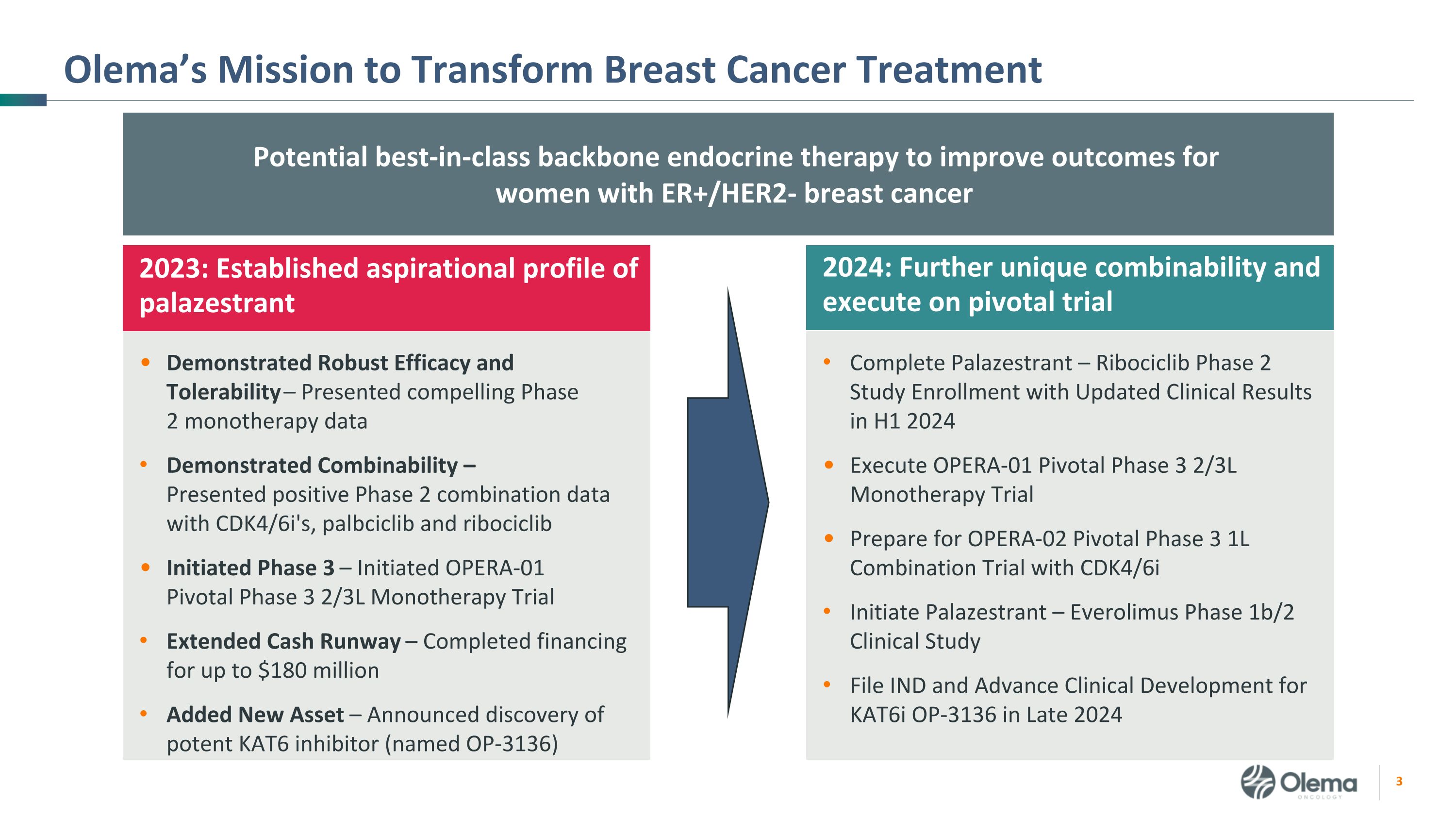
Olema’s Mission to Transform Breast Cancer Treatment Potential best-in-class backbone endocrine therapy to improve outcomes for �women with ER+/HER2- breast cancer 2024: Further unique combinability and execute on pivotal trial Complete Palazestrant – Ribociclib Phase 2 Study Enrollment with Updated Clinical Results in H1 2024 Execute OPERA-01 Pivotal Phase 3 2/3L Monotherapy Trial Prepare for OPERA-02 Pivotal Phase 3 1L Combination Trial with CDK4/6i Initiate Palazestrant – Everolimus Phase 1b/2 Clinical Study File IND and Advance Clinical Development for KAT6i OP-3136 in Late 2024 2023: Established aspirational profile of palazestrant Demonstrated Robust Efficacy and Tolerability – Presented compelling Phase 2 monotherapy data Demonstrated Combinability – Presented positive Phase 2 combination data with CDK4/6i's, palbciclib and ribociclib Initiated Phase 3 – Initiated OPERA-01 Pivotal Phase 3 2/3L Monotherapy Trial Extended Cash Runway – Completed financing for up to $180 million Added New Asset – Announced discovery of potent KAT6 inhibitor (named OP-3136)
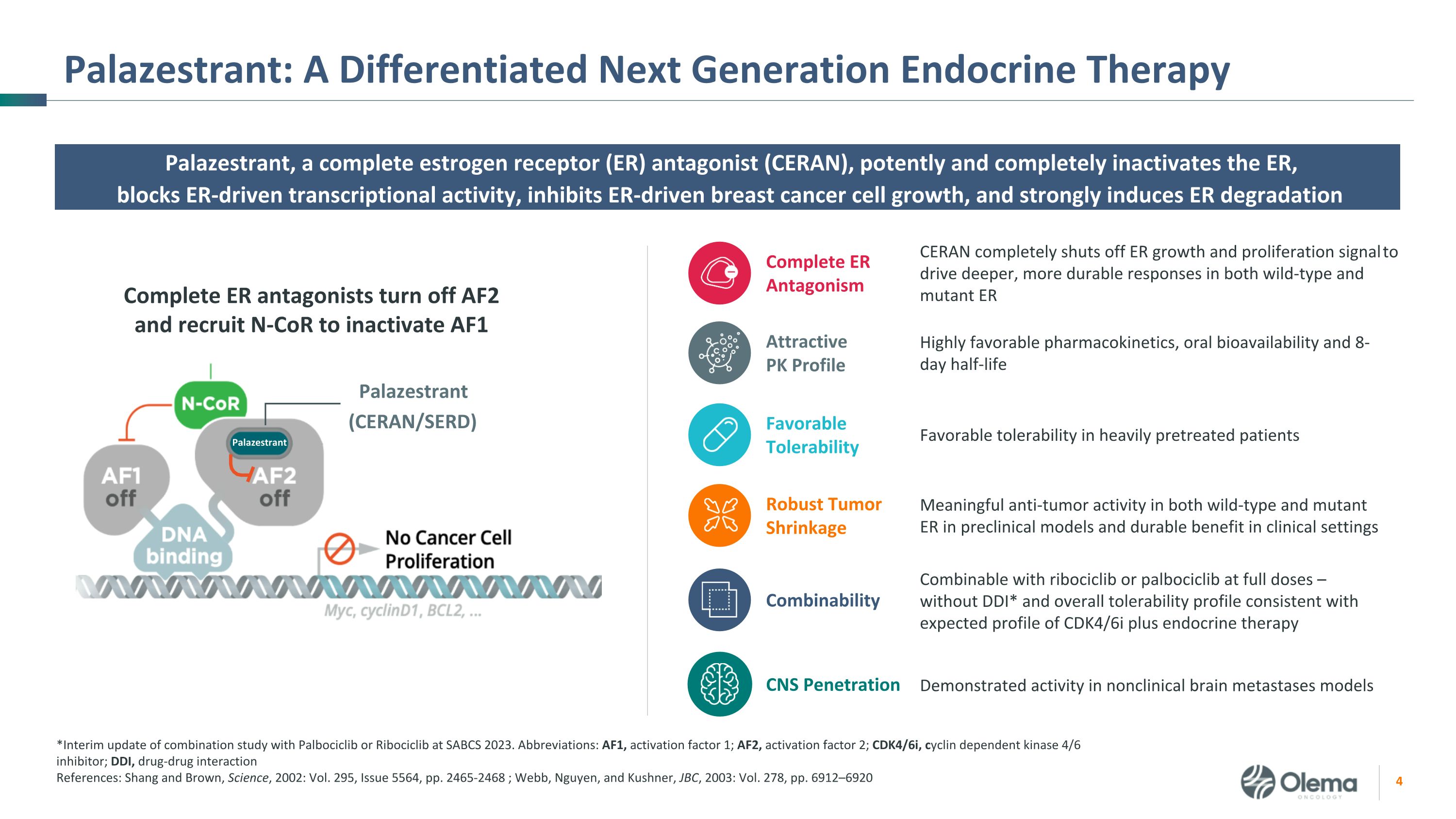
Palazestrant: A Differentiated Next Generation Endocrine Therapy Palazestrant, a complete estrogen receptor (ER) antagonist (CERAN), potently and completely inactivates the ER, �blocks ER-driven transcriptional activity, inhibits ER-driven breast cancer cell growth, and strongly induces ER degradation Complete ER antagonists turn off AF2�and recruit N-CoR to inactivate AF1 Palazestrant Palazestrant ��(CERAN/SERD) Complete ER �Antagonism CERAN completely shuts off ER growth and proliferation signal to drive deeper, more durable responses in both wild-type and mutant ER Attractive �PK Profile Highly favorable pharmacokinetics, oral bioavailability and 8-day half-life Favorable �Tolerability Favorable tolerability in heavily pretreated patients Robust Tumor �Shrinkage Meaningful anti-tumor activity in both wild-type and mutant ER in preclinical models and durable benefit in clinical settings Combinability Combinable with ribociclib or palbociclib at full doses – without DDI* and overall tolerability profile consistent with expected profile of CDK4/6i plus endocrine therapy CNS Penetration Demonstrated activity in nonclinical brain metastases models *Interim update of combination study with Palbociclib or Ribociclib at SABCS 2023. Abbreviations: AF1, activation factor 1; AF2, activation factor 2; CDK4/6i, cyclin dependent kinase 4/6 inhibitor; DDI, drug-drug interaction References: Shang and Brown, Science, 2002: Vol. 295, Issue 5564, pp. 2465-2468 ; Webb, Nguyen, and Kushner, JBC, 2003: Vol. 278, pp. 6912–6920
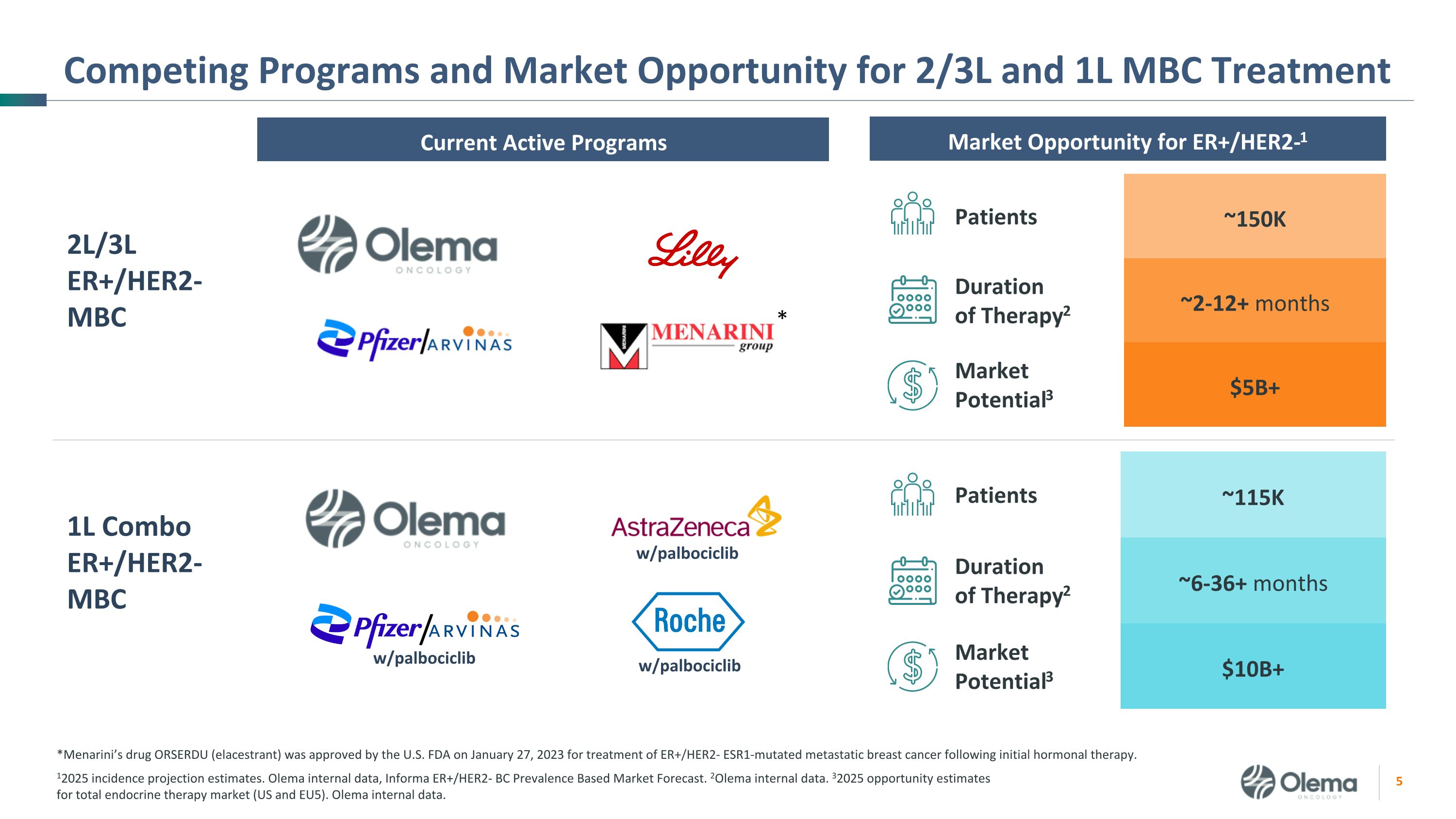
Competing Programs and Market Opportunity for 2/3L and 1L MBC Treatment Current Active Programs 2L/3L ER+/HER2- MBC 1L Combo ER+/HER2- MBC * *Menarini’s drug ORSERDU (elacestrant) was approved by the U.S. FDA on January 27, 2023 for treatment of ER+/HER2- ESR1-mutated metastatic breast cancer following initial hormonal therapy. / Patients ~150K Duration �of Therapy2 ~2-12+ months Market �Potential3 $5B+ Patients ~115K Duration �of Therapy2 ~6-36+ months Market �Potential3 $10B+ Market Opportunity for ER+/HER2-1 12025 incidence projection estimates. Olema internal data, Informa ER+/HER2- BC Prevalence Based Market Forecast. 2Olema internal data. 32025 opportunity estimates for total endocrine therapy market (US and EU5). Olema internal data. w/palbociclib w/palbociclib w/palbociclib
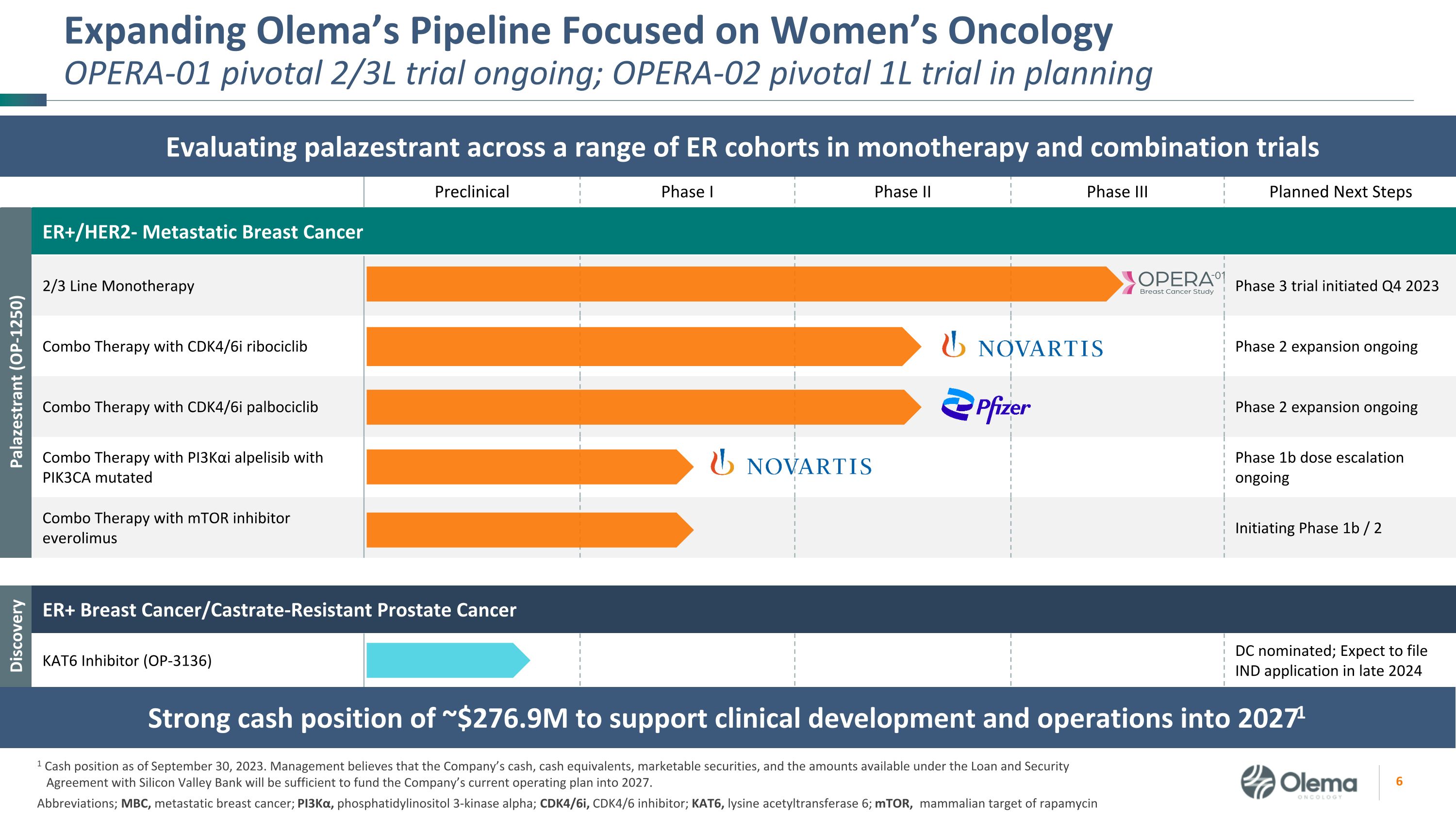
Preclinical Phase I Phase II Phase III Planned Next Steps Palazestrant (OP-1250) ER+/HER2- Metastatic Breast Cancer 2/3 Line Monotherapy Phase 3 trial initiated Q4 2023 Combo Therapy with CDK4/6i ribociclib Phase 2 expansion ongoing Combo Therapy with CDK4/6i palbociclib Phase 2 expansion ongoing Combo Therapy with PI3Kαi alpelisib with PIK3CA mutated Phase 1b dose escalation ongoing Combo Therapy with mTOR inhibitor everolimus Initiating Phase 1b / 2 Discovery ER+ Breast Cancer/Castrate-Resistant Prostate Cancer Discovery KAT6 Inhibitor (OP-3136) DC nominated; Expect to file IND application in late 2024 Expanding Olema’s Pipeline Focused on Women’s Oncology�OPERA-01 pivotal 2/3L trial ongoing; OPERA-02 pivotal 1L trial in planning Abbreviations; MBC, metastatic breast cancer; PI3Kα, phosphatidylinositol 3-kinase alpha; CDK4/6i, CDK4/6 inhibitor; KAT6, lysine acetyltransferase 6; mTOR, mammalian target of rapamycin Evaluating palazestrant across a range of ER cohorts in monotherapy and combination trials Strong cash position of ~$276.9M to support clinical development and operations into 20271 1 Cash position as of September 30, 2023. Management believes that the Company’s cash, cash equivalents, marketable securities, and the amounts available under the Loan and Security� Agreement with Silicon Valley Bank will be sufficient to fund the Company’s current operating plan into 2027.
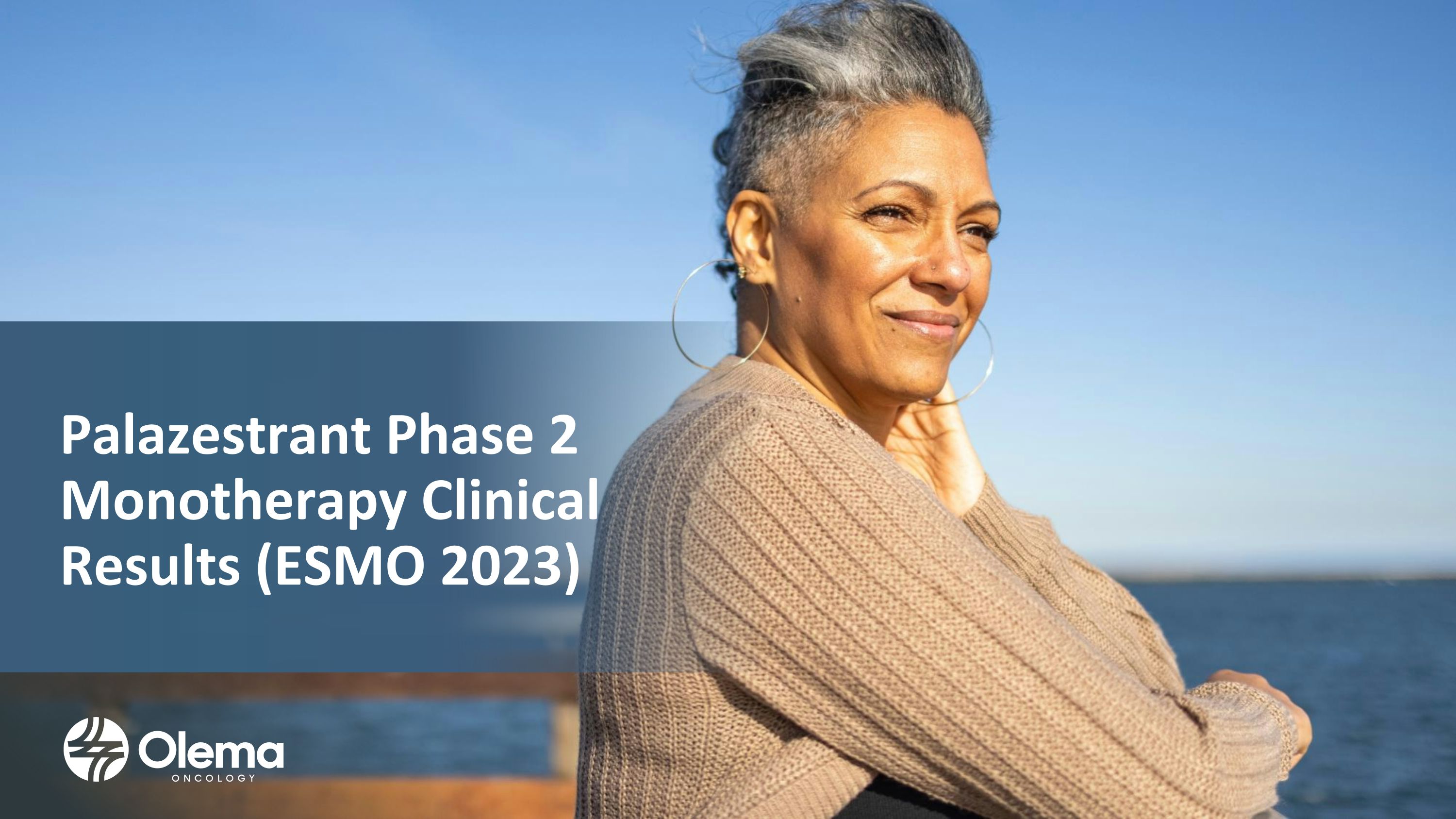
Palazestrant Phase 2 Monotherapy Clinical Results (ESMO 2023)
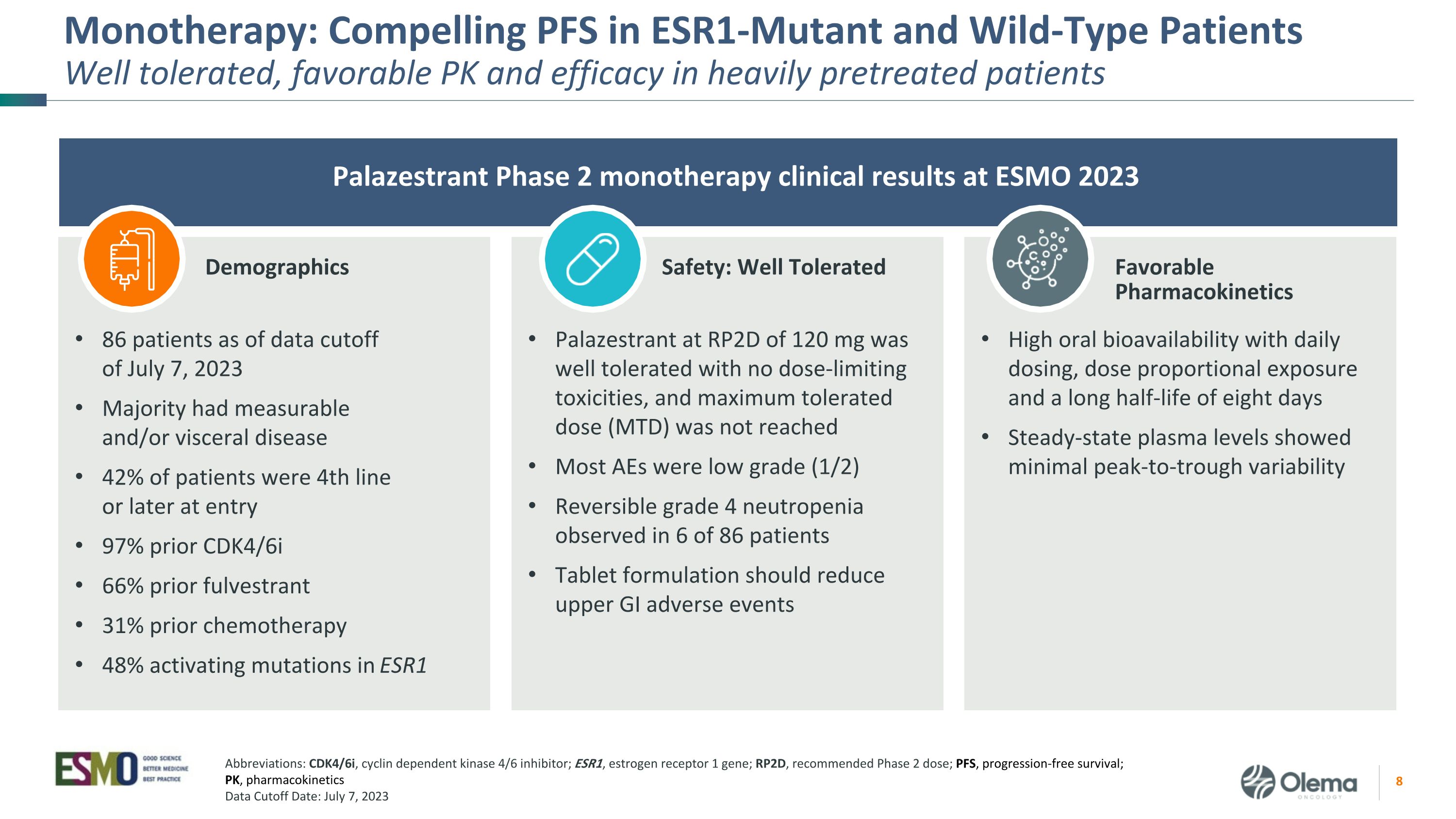
Monotherapy: Compelling PFS in ESR1-Mutant and Wild-Type Patients�Well tolerated, favorable PK and efficacy in heavily pretreated patients Palazestrant Phase 2 monotherapy clinical results at ESMO 2023 High oral bioavailability with daily dosing, dose proportional exposure and a long half-life of eight days Steady-state plasma levels showed minimal peak-to-trough variability 86 patients as of data cutoff �of July 7, 2023 Majority had measurable �and/or visceral disease 42% of patients were 4th line �or later at entry 97% prior CDK4/6i 66% prior fulvestrant 31% prior chemotherapy 48% activating mutations in ESR1 Palazestrant at RP2D of 120 mg was well tolerated with no dose-limiting toxicities, and maximum tolerated dose (MTD) was not reached Most AEs were low grade (1/2) Reversible grade 4 neutropenia observed in 6 of 86 patients Tablet formulation should reduce upper GI adverse events Demographics Safety: Well Tolerated Favorable Pharmacokinetics Abbreviations: CDK4/6i, cyclin dependent kinase 4/6 inhibitor; ESR1, estrogen receptor 1 gene; RP2D, recommended Phase 2 dose; PFS, progression-free survival; PK, pharmacokinetics Data Cutoff Date: July 7, 2023
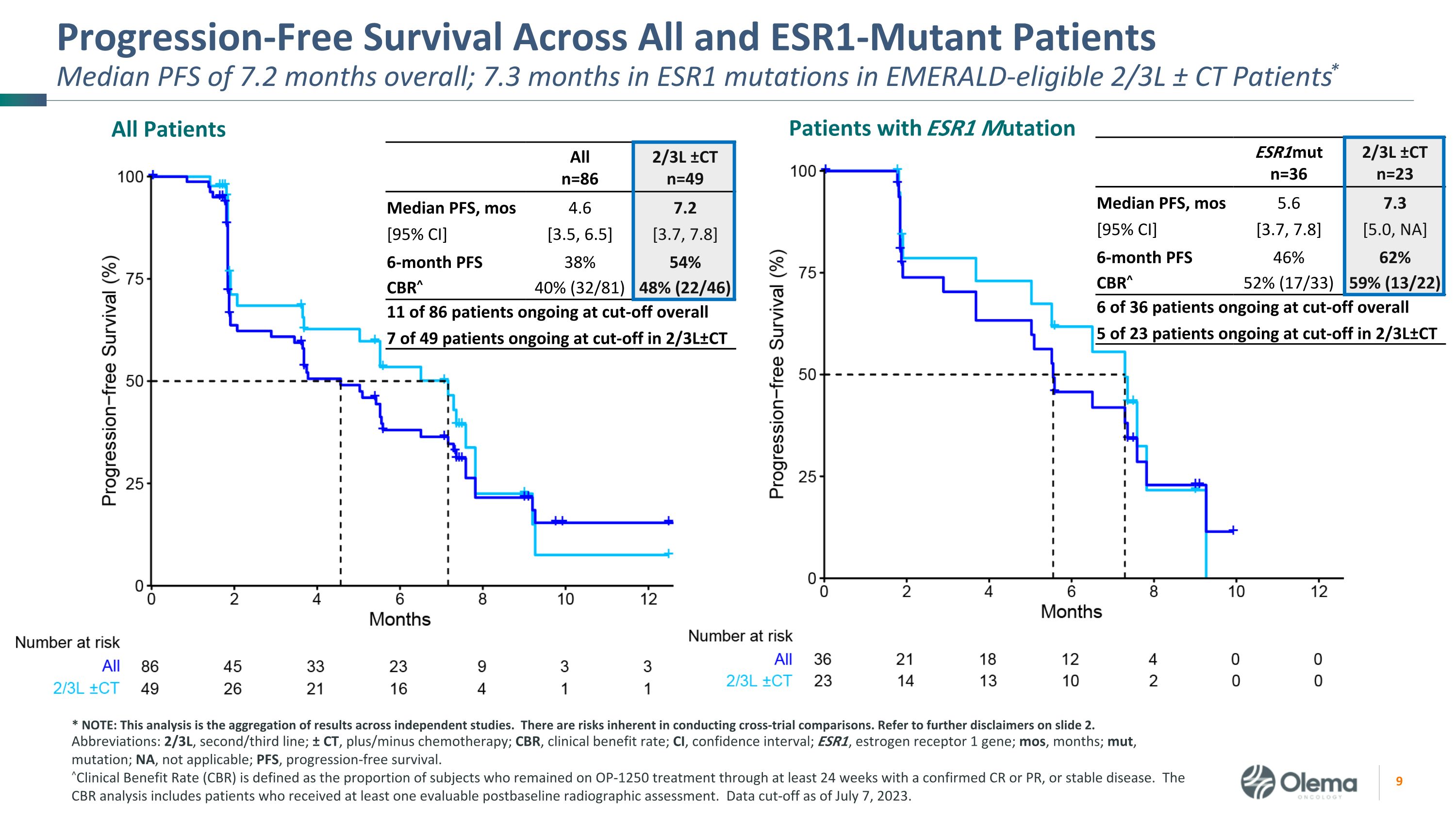
Progression-Free Survival Across All and ESR1-Mutant Patients�Median PFS of 7.2 months overall; 7.3 months in ESR1 mutations in EMERALD-eligible 2/3L ± CT Patients* All Patients Patients with ESR1 Mutation All�n=86 2/3L ±CT�n=49 Median PFS, mos [95% CI] 4.6 [3.5, 6.5] 7.2 [3.7, 7.8] 6-month PFS 38% 54% CBR^ 40% (32/81) 48% (22/46) 11 of 86 patients ongoing at cut-off overall 7 of 49 patients ongoing at cut-off in 2/3L±CT ESR1mut�n=36 2/3L ±CT�n=23 Median PFS, mos [95% CI] 5.6 [3.7, 7.8] 7.3 [5.0, NA] 6-month PFS 46% 62% CBR^ 52% (17/33) 59% (13/22) 6 of 36 patients ongoing at cut-off overall 5 of 23 patients ongoing at cut-off in 2/3L±CT Abbreviations: 2/3L, second/third line; ± CT, plus/minus chemotherapy; CBR, clinical benefit rate; CI, confidence interval; ESR1, estrogen receptor 1 gene; mos, months; mut, mutation; NA, not applicable; PFS, progression-free survival. ^Clinical Benefit Rate (CBR) is defined as the proportion of subjects who remained on OP-1250 treatment through at least 24 weeks with a confirmed CR or PR, or stable disease. The CBR analysis includes patients who received at least one evaluable postbaseline radiographic assessment. Data cut-off as of July 7, 2023. * NOTE: This analysis is the aggregation of results across independent studies. There are risks inherent in conducting cross-trial comparisons. Refer to further disclaimers on slide 2.
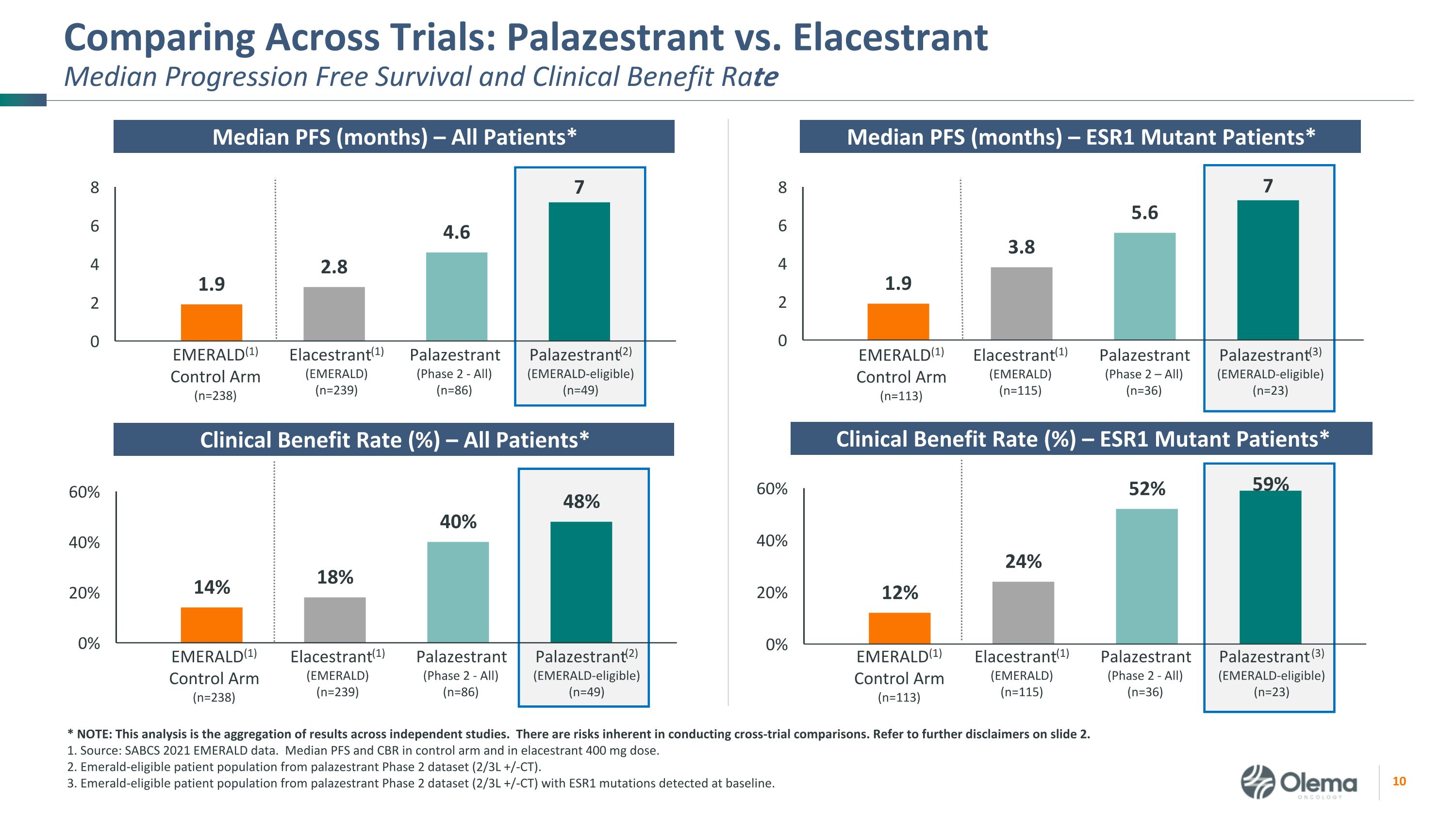
Comparing Across Trials: Palazestrant vs. Elacestrant �Median Progression Free Survival and Clinical Benefit Rate EMERALD(1) �Control Arm�(n=238) Elacestrant(1) (EMERALD)�(n=239) Palazestrant(2) (EMERALD-eligible)�(n=49) Palazestrant (Phase 2 - All)�(n=86) EMERALD(1) �Control Arm�(n=113) Elacestrant(1) (EMERALD)�(n=115) Palazestrant(3) (EMERALD-eligible)�(n=23) Palazestrant (Phase 2 – All)�(n=36) Median PFS (months) – All Patients* Median PFS (months) – ESR1 Mutant Patients* Clinical Benefit Rate (%) – All Patients* Clinical Benefit Rate (%) – ESR1 Mutant Patients* EMERALD(1) �Control Arm�(n=238) Elacestrant(1) (EMERALD)�(n=239) Palazestrant(2) (EMERALD-eligible)�(n=49) Palazestrant (Phase 2 - All)�(n=86) EMERALD(1) Control Arm�(n=113) Elacestrant(1) (EMERALD)�(n=115) Palazestrant (3) (EMERALD-eligible)�(n=23) Palazestrant (Phase 2 - All)�(n=36) * NOTE: This analysis is the aggregation of results across independent studies. There are risks inherent in conducting cross-trial comparisons. Refer to further disclaimers on slide 2. 1. Source: SABCS 2021 EMERALD data. Median PFS and CBR in control arm and in elacestrant 400 mg dose. 2. Emerald-eligible patient population from palazestrant Phase 2 dataset (2/3L +/-CT). 3. Emerald-eligible patient population from palazestrant Phase 2 dataset (2/3L +/-CT) with ESR1 mutations detected at baseline.
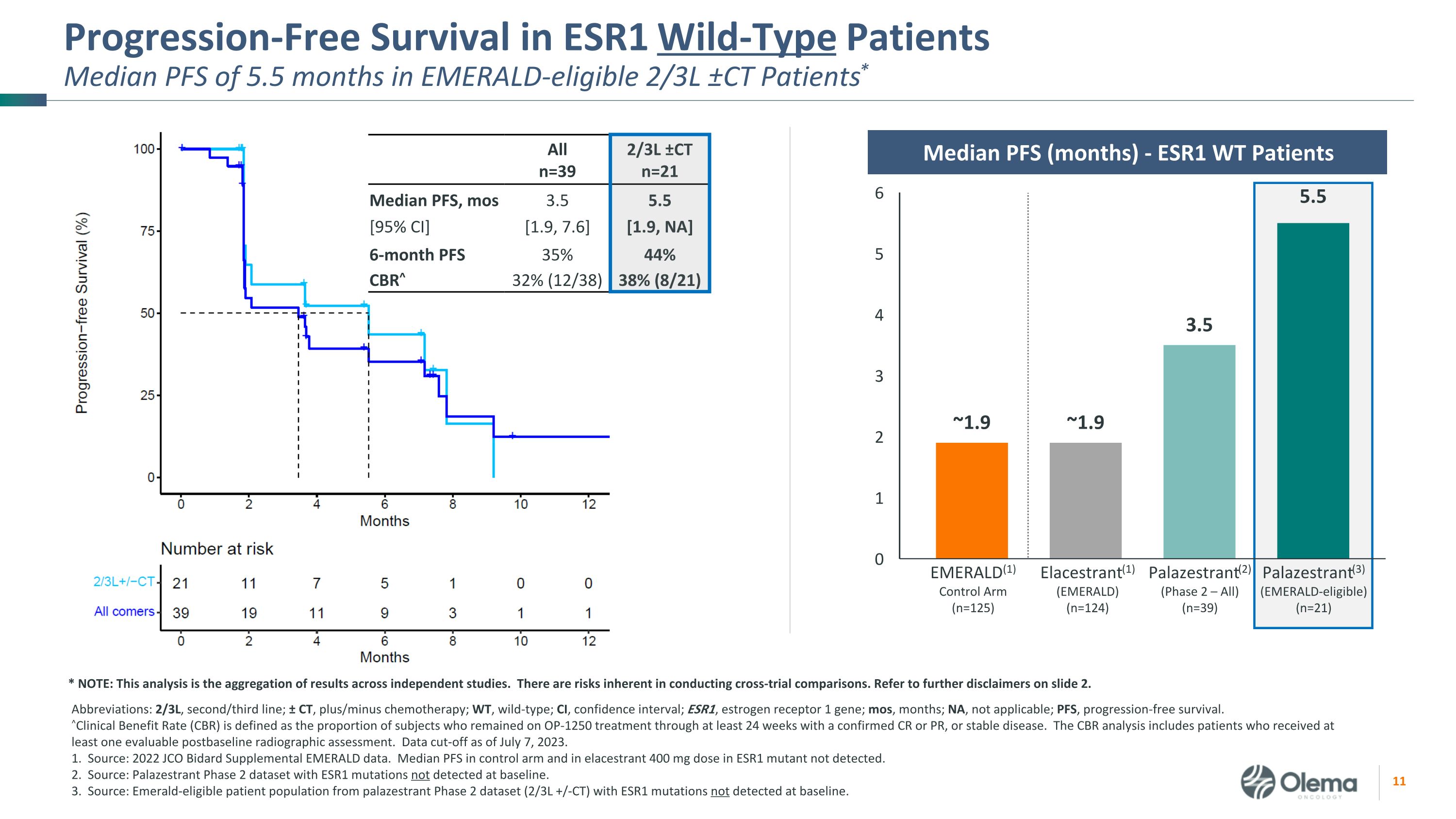
Progression-Free Survival in ESR1 Wild-Type Patients�Median PFS of 5.5 months in EMERALD-eligible 2/3L ±CT Patients* Abbreviations: 2/3L, second/third line; ± CT, plus/minus chemotherapy; WT, wild-type; CI, confidence interval; ESR1, estrogen receptor 1 gene; mos, months; NA, not applicable; PFS, progression-free survival. ^Clinical Benefit Rate (CBR) is defined as the proportion of subjects who remained on OP-1250 treatment through at least 24 weeks with a confirmed CR or PR, or stable disease. The CBR analysis includes patients who received at least one evaluable postbaseline radiographic assessment. Data cut-off as of July 7, 2023. 1. Source: 2022 JCO Bidard Supplemental EMERALD data. Median PFS in control arm and in elacestrant 400 mg dose in ESR1 mutant not detected. 2. Source: Palazestrant Phase 2 dataset with ESR1 mutations not detected at baseline. 3. Source: Emerald-eligible patient population from palazestrant Phase 2 dataset (2/3L +/-CT) with ESR1 mutations not detected at baseline. All�n=39 2/3L ±CT�n=21 Median PFS, mos [95% CI] 3.5 [1.9, 7.6] 5.5 [1.9, NA] 6-month PFS 35% 44% CBR^ 32% (12/38) 38% (8/21) EMERALD(1) �Control Arm�(n=125) Elacestrant(1) (EMERALD)�(n=124) Palazestrant(3) (EMERALD-eligible)�(n=21) Palazestrant(2) (Phase 2 – All)�(n=39) Median PFS (months) - ESR1 WT Patients * NOTE: This analysis is the aggregation of results across independent studies. There are risks inherent in conducting cross-trial comparisons. Refer to further disclaimers on slide 2.
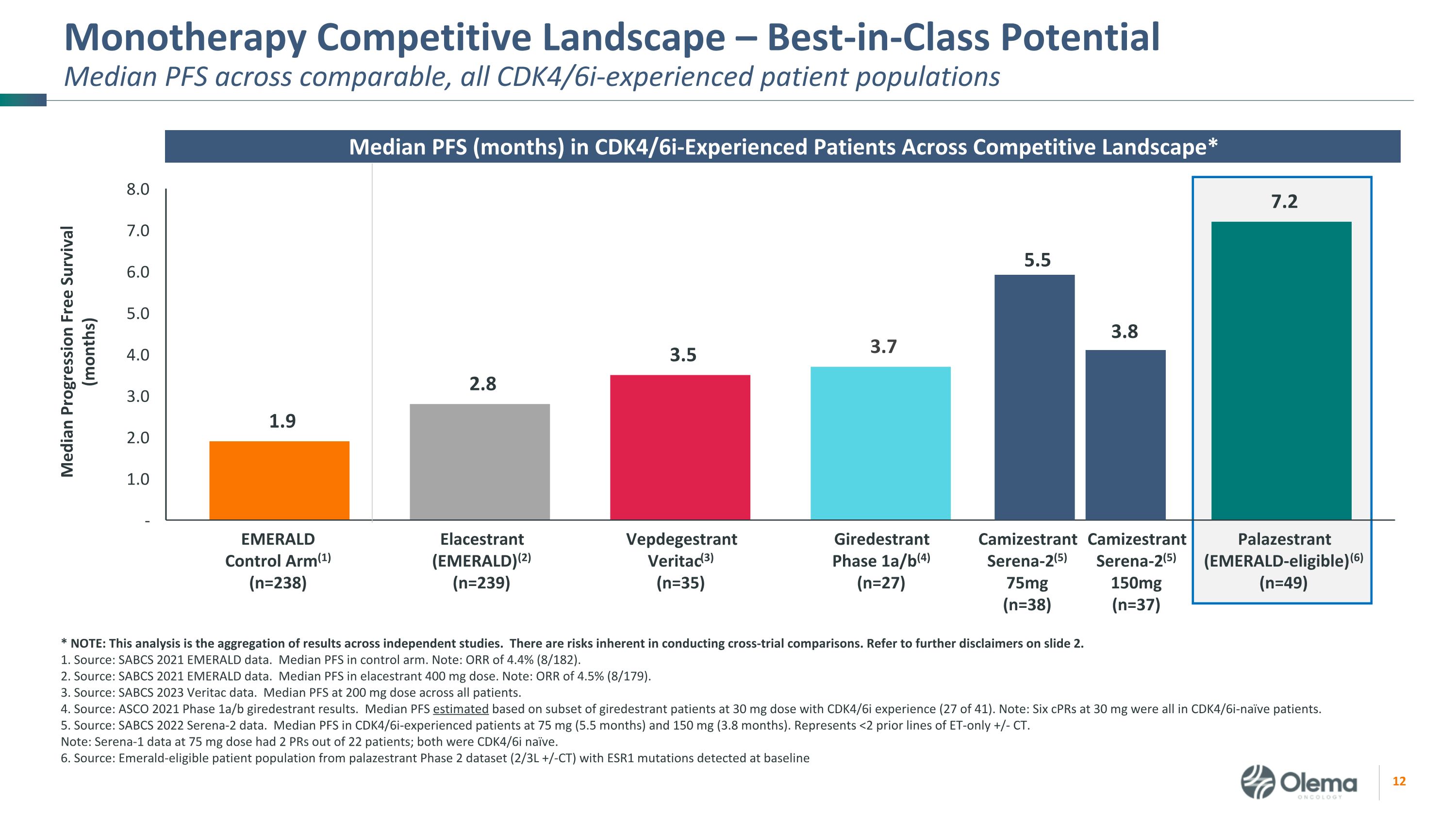
Monotherapy Competitive Landscape – Best-in-Class Potential�Median PFS across comparable, all CDK4/6i-experienced patient populations * NOTE: This analysis is the aggregation of results across independent studies. There are risks inherent in conducting cross-trial comparisons. Refer to further disclaimers on slide 2. 1. Source: SABCS 2021 EMERALD data. Median PFS in control arm. Note: ORR of 4.4% (8/182). 2. Source: SABCS 2021 EMERALD data. Median PFS in elacestrant 400 mg dose. Note: ORR of 4.5% (8/179). 3. Source: SABCS 2023 Veritac data. Median PFS at 200 mg dose across all patients. 4. Source: ASCO 2021 Phase 1a/b giredestrant results. Median PFS estimated based on subset of giredestrant patients at 30 mg dose with CDK4/6i experience (27 of 41). Note: Six cPRs at 30 mg were all in CDK4/6i-naïve patients. 5. Source: SABCS 2022 Serena-2 data. Median PFS in CDK4/6i-experienced patients at 75 mg (5.5 months) and 150 mg (3.8 months). Represents <2 prior lines of ET-only +/- CT. �Note: Serena-1 data at 75 mg dose had 2 PRs out of 22 patients; both were CDK4/6i naïve. 6. Source: Emerald-eligible patient population from palazestrant Phase 2 dataset (2/3L +/-CT) with ESR1 mutations detected at baseline Median Progression Free Survival (months) EMERALD Control Arm(1)�(n=238) Elacestrant (EMERALD)(2)�(n=239) Palazestrant (EMERALD-eligible)(6)�(n=49) Camizestrant Serena-2(5) 150mg (n=37) Giredestrant Phase 1a/b(4) (n=27) Vepdegestrant Veritac(3)�(n=35) Median PFS (months) in CDK4/6i-Experienced Patients Across Competitive Landscape* 3.8 5.5 Camizestrant Serena-2(5) 75mg (n=38)

Phase 1b/2 �Combination Clinical �Results (SABCS 2023)
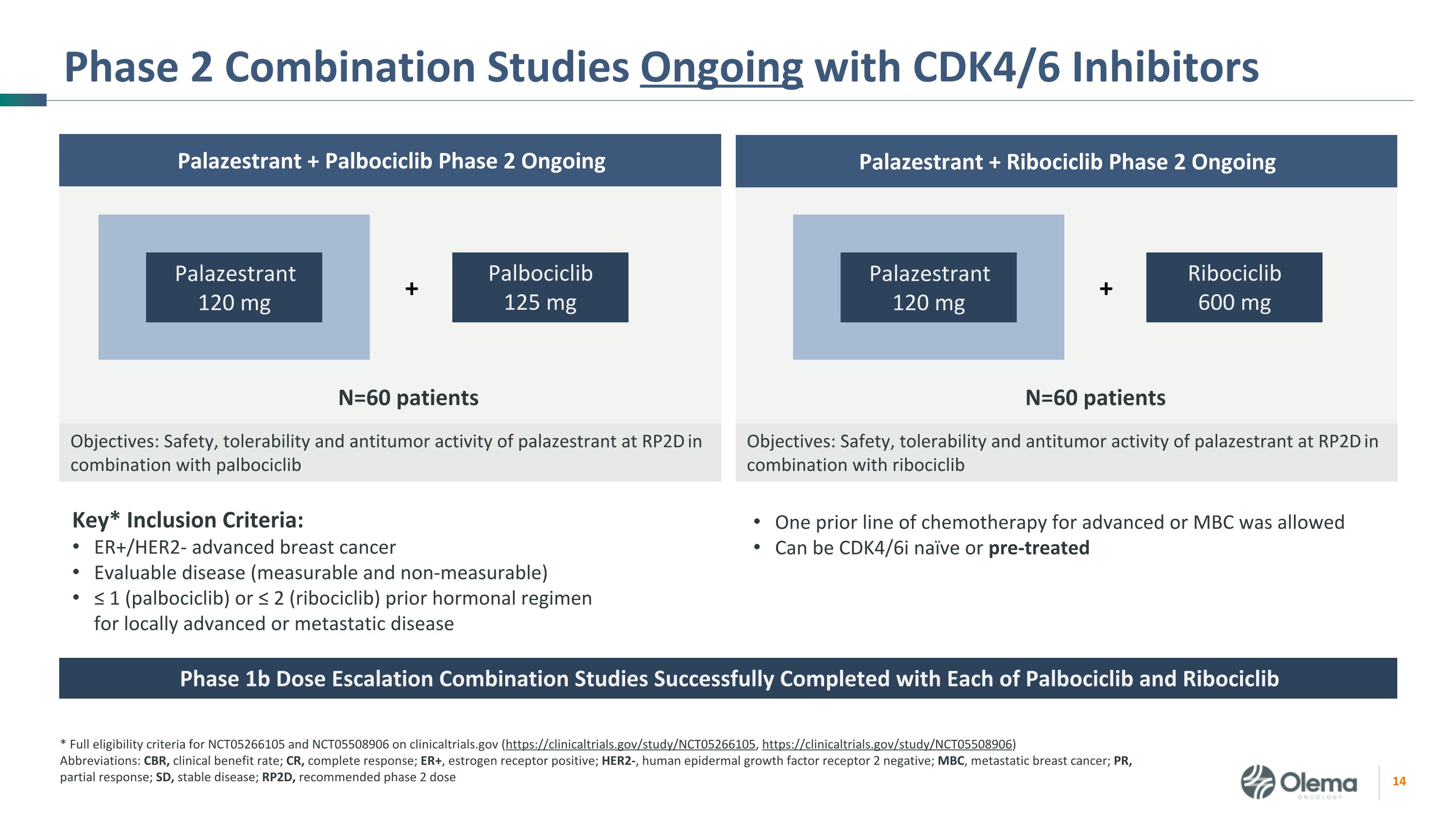
Phase 2 Combination Studies Ongoing with CDK4/6 Inhibitors Key* Inclusion Criteria: ER+/HER2- advanced breast cancer Evaluable disease (measurable and non-measurable) ≤ 1 (palbociclib) or ≤ 2 (ribociclib) prior hormonal regimen for locally advanced or metastatic disease * Full eligibility criteria for NCT05266105 and NCT05508906 on clinicaltrials.gov (https://clinicaltrials.gov/study/NCT05266105, https://clinicaltrials.gov/study/NCT05508906) Abbreviations: CBR, clinical benefit rate; CR, complete response; ER+, estrogen receptor positive; HER2-, human epidermal growth factor receptor 2 negative; MBC, metastatic breast cancer; PR, partial response; SD, stable disease; RP2D, recommended phase 2 dose Palazestrant + Ribociclib Phase 2 Ongoing Objectives: Safety, tolerability and antitumor activity of palazestrant at RP2D in combination with palbociclib Palazestrant �120 mg Palbociclib �125 mg + N=60 patients N=60 patients Objectives: Safety, tolerability and antitumor activity of palazestrant at RP2D in combination with ribociclib Palazestrant + Palbociclib Phase 2 Ongoing Palazestrant �120 mg Ribociclib 600 mg + One prior line of chemotherapy for advanced or MBC was allowed Can be CDK4/6i naïve or pre-treated Phase 1b Dose Escalation Combination Studies Successfully Completed with Each of Palbociclib and Ribociclib
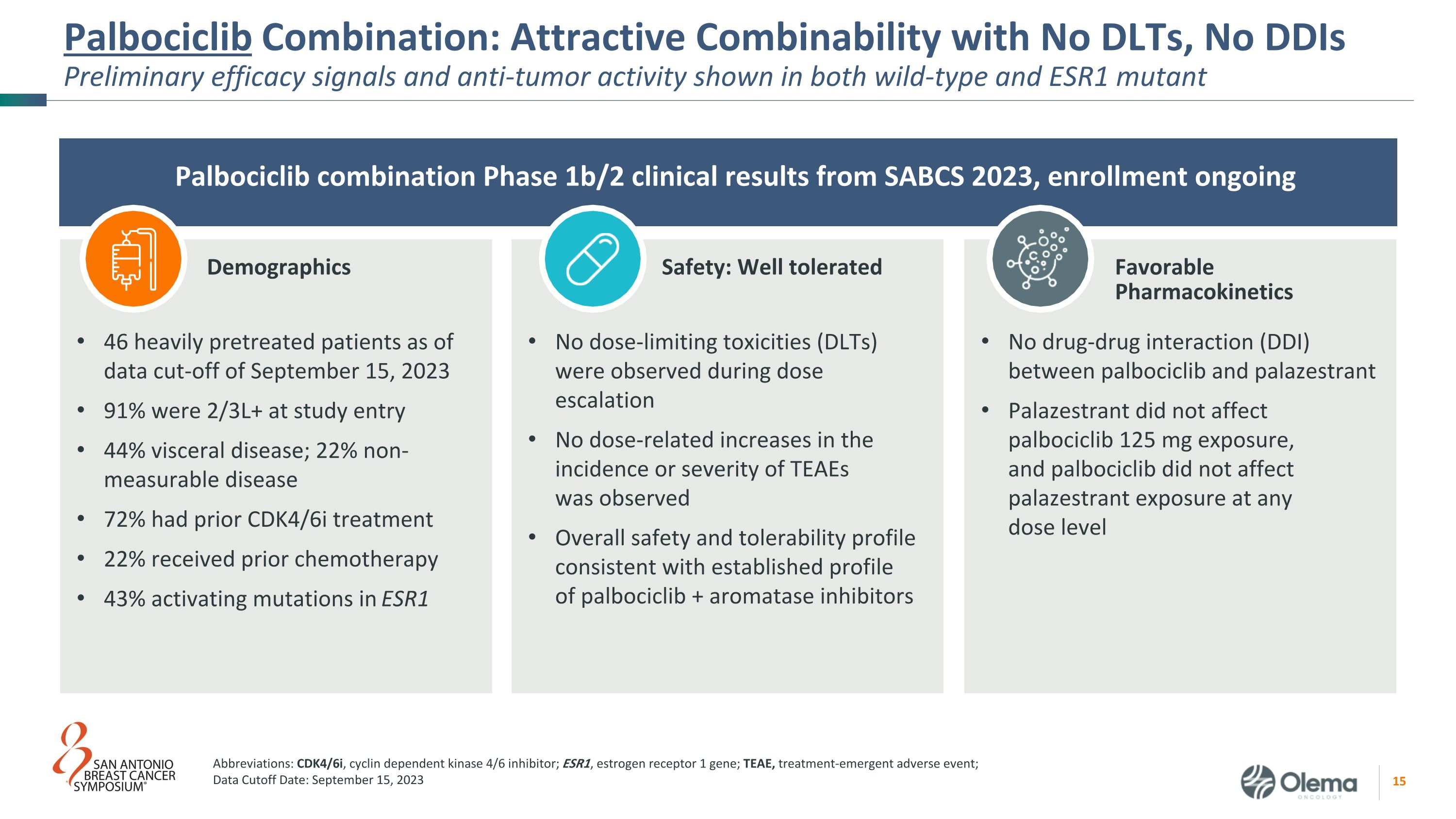
Palbociclib Combination: Attractive Combinability with No DLTs, No DDIs�Preliminary efficacy signals and anti-tumor activity shown in both wild-type and ESR1 mutant Palbociclib combination Phase 1b/2 clinical results from SABCS 2023, enrollment ongoing No drug-drug interaction (DDI) between palbociclib and palazestrant Palazestrant did not affect palbociclib 125 mg exposure, �and palbociclib did not affect palazestrant exposure at any �dose level 46 heavily pretreated patients as of data cut-off of September 15, 2023 91% were 2/3L+ at study entry 44% visceral disease; 22% non-measurable disease 72% had prior CDK4/6i treatment 22% received prior chemotherapy 43% activating mutations in ESR1 No dose-limiting toxicities (DLTs) were observed during dose escalation No dose-related increases in the incidence or severity of TEAEs �was observed Overall safety and tolerability profile consistent with established profile of palbociclib + aromatase inhibitors Abbreviations: CDK4/6i, cyclin dependent kinase 4/6 inhibitor; ESR1, estrogen receptor 1 gene; TEAE, treatment-emergent adverse event; Data Cutoff Date: September 15, 2023 Demographics Safety: Well tolerated Favorable Pharmacokinetics
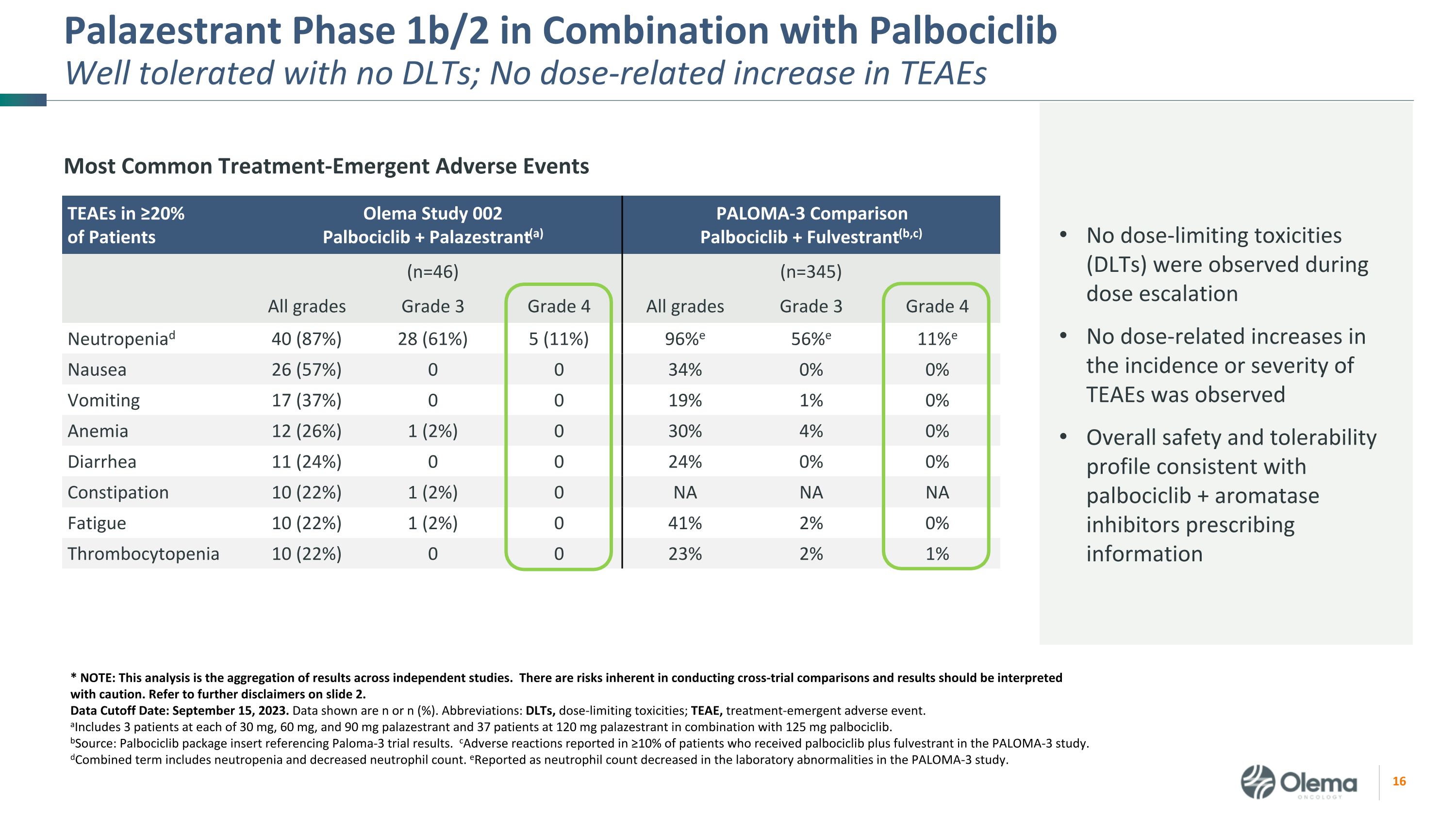
Palazestrant Phase 1b/2 in Combination with Palbociclib �Well tolerated with no DLTs; No dose-related increase in TEAEs Most Common Treatment-Emergent Adverse Events TEAEs in ≥20% �of Patients Olema Study 002�Palbociclib + Palazestrant(a) PALOMA-3 Comparison�Palbociclib + Fulvestrant(b,c) (n=46) (n=345) All grades Grade 3 Grade 4 All grades Grade 3 Grade 4 Neutropeniad 40 (87%) 28 (61%) 5 (11%) 96%e 56%e 11%e Nausea 26 (57%) 0 0 34% 0% 0% Vomiting 17 (37%) 0 0 19% 1% 0% Anemia 12 (26%) 1 (2%) 0 30% 4% 0% Diarrhea 11 (24%) 0 0 24% 0% 0% Constipation 10 (22%) 1 (2%) 0 NA NA NA Fatigue 10 (22%) 1 (2%) 0 41% 2% 0% Thrombocytopenia 10 (22%) 0 0 23% 2% 1% * NOTE: This analysis is the aggregation of results across independent studies. There are risks inherent in conducting cross-trial comparisons and results should be interpreted with caution. Refer to further disclaimers on slide 2. Data Cutoff Date: September 15, 2023. Data shown are n or n (%). Abbreviations: DLTs, dose-limiting toxicities; TEAE, treatment-emergent adverse event.�aIncludes 3 patients at each of 30 mg, 60 mg, and 90 mg palazestrant and 37 patients at 120 mg palazestrant in combination with 125 mg palbociclib. bSource: Palbociclib package insert referencing Paloma-3 trial results. cAdverse reactions reported in ≥10% of patients who received palbociclib plus fulvestrant in the PALOMA-3 study. dCombined term includes neutropenia and decreased neutrophil count. eReported as neutrophil count decreased in the laboratory abnormalities in the PALOMA-3 study. No dose-limiting toxicities (DLTs) were observed during dose escalation No dose-related increases in the incidence or severity of TEAEs was observed Overall safety and tolerability profile consistent with palbociclib + aromatase inhibitors prescribing information
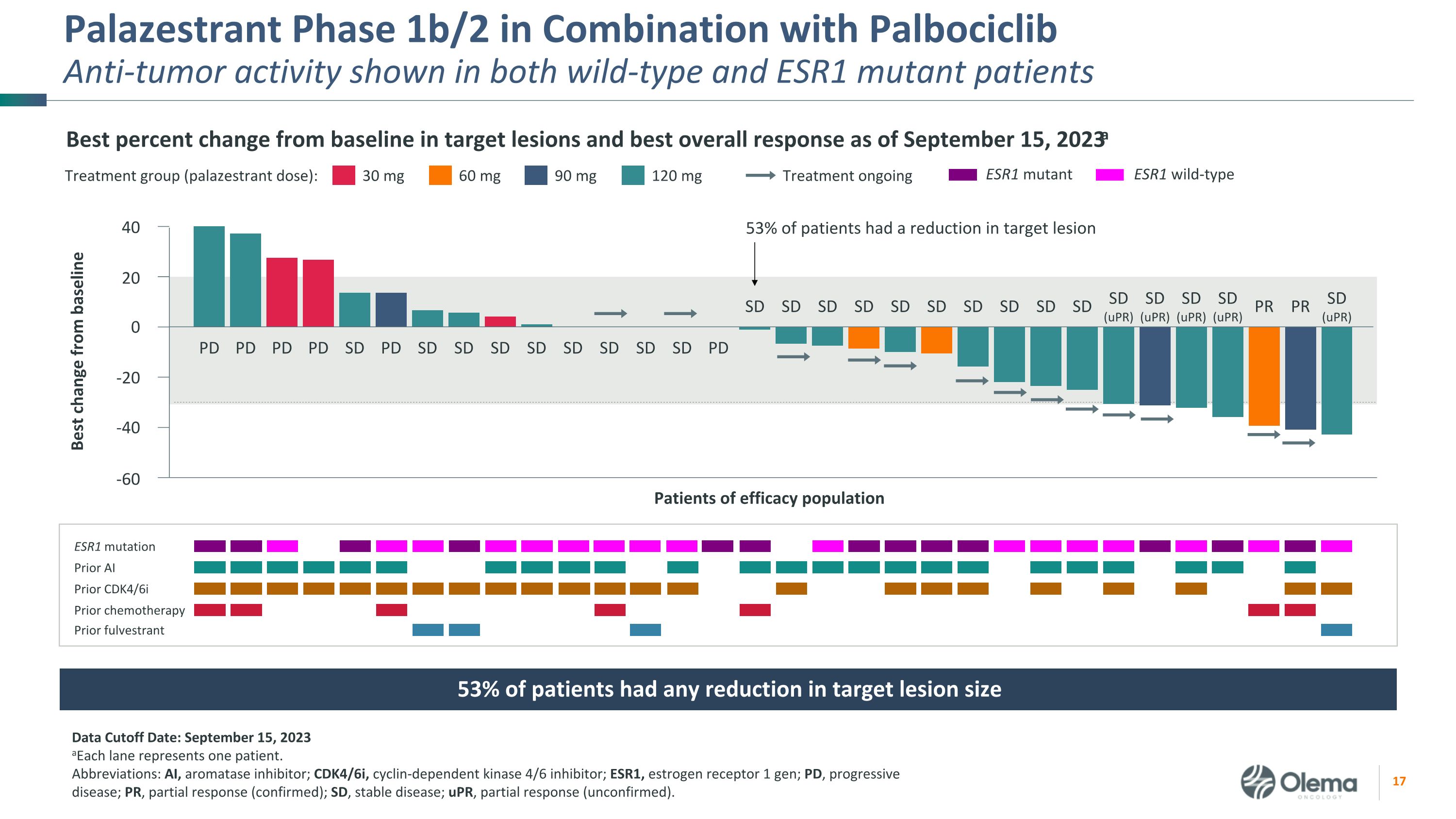
Palazestrant Phase 1b/2 in Combination with Palbociclib�Anti-tumor activity shown in both wild-type and ESR1 mutant patients Best percent change from baseline in target lesions and best overall response as of September 15, 2023a Data Cutoff Date: September 15, 2023 aEach lane represents one patient. Abbreviations: AI, aromatase inhibitor; CDK4/6i, cyclin-dependent kinase 4/6 inhibitor; ESR1, estrogen receptor 1 gen; PD, progressive disease; PR, partial response (confirmed); SD, stable disease; uPR, partial response (unconfirmed). 30 mg Treatment group (palazestrant dose): 60 mg 90 mg 120 mg Treatment ongoing ESR1 mutation Prior AI Prior CDK4/6i Prior chemotherapy Prior fulvestrant Patients of efficacy population PD PD PD PD SD PD SD SD SD SD SD SD SD SD PD SD SD SD SD SD SD SD SD SD SD SD�(uPR) SD�(uPR) SD�(uPR) SD�(uPR) PR PR SD�(uPR) 53% of patients had a reduction in target lesion 40 20 0 -20 -40 -60 Best change from baseline ESR1 mutant ESR1 wild-type 53% of patients had any reduction in target lesion size
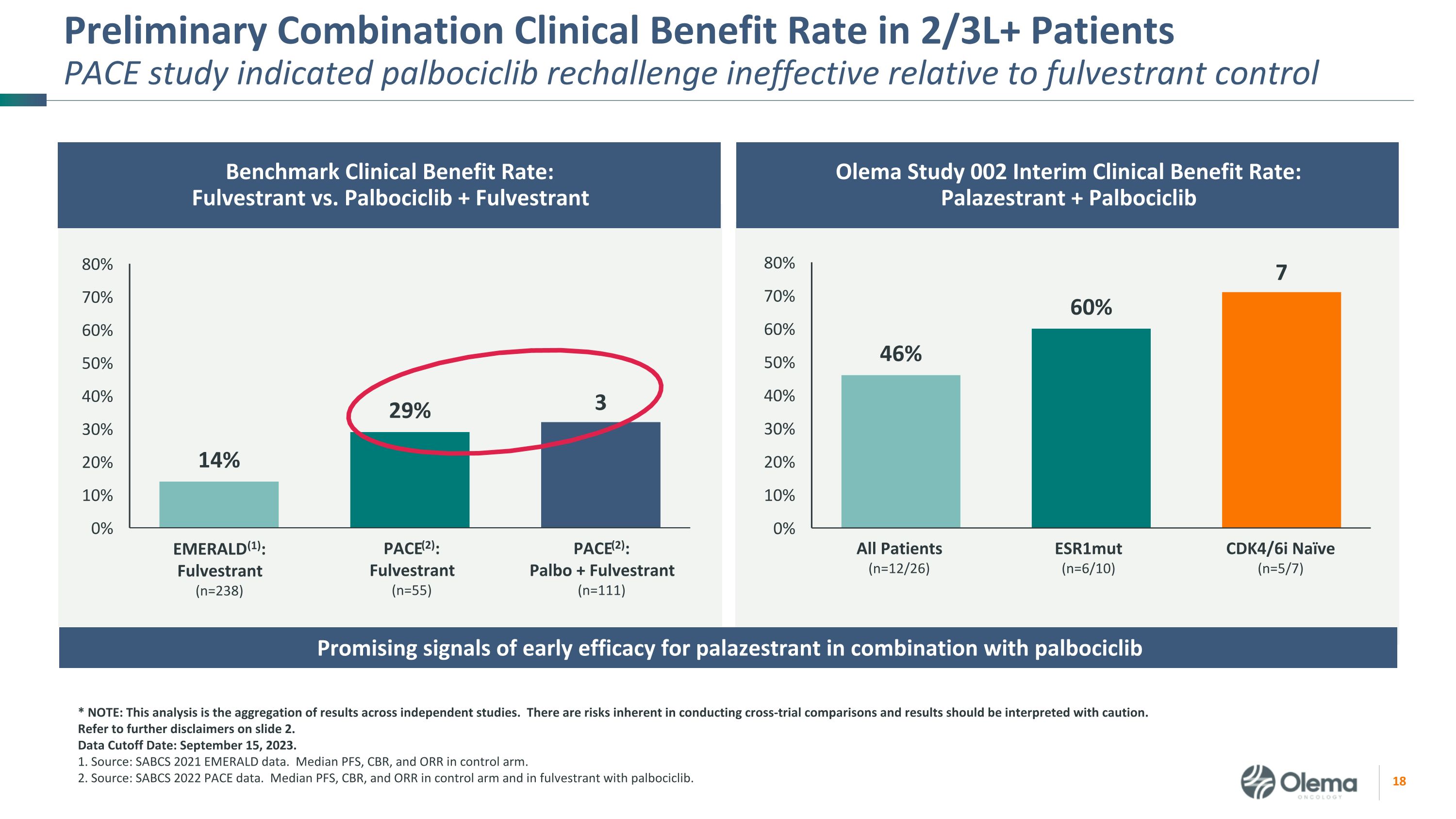
Preliminary Combination Clinical Benefit Rate in 2/3L+ Patients�PACE study indicated palbociclib rechallenge ineffective relative to fulvestrant control All Patients�(n=12/26) ESR1mut�(n=6/10) CDK4/6i Naïve�(n=5/7) Benchmark Clinical Benefit Rate: �Fulvestrant vs. Palbociclib + Fulvestrant Olema Study 002 Interim Clinical Benefit Rate:�Palazestrant + Palbociclib * NOTE: This analysis is the aggregation of results across independent studies. There are risks inherent in conducting cross-trial comparisons and results should be interpreted with caution. �Refer to further disclaimers on slide 2. Data Cutoff Date: September 15, 2023. 1. Source: SABCS 2021 EMERALD data. Median PFS, CBR, and ORR in control arm. 2. Source: SABCS 2022 PACE data. Median PFS, CBR, and ORR in control arm and in fulvestrant with palbociclib. PACE(2): Fulvestrant�(n=55) PACE(2): �Palbo + Fulvestrant�(n=111) EMERALD(1): Fulvestrant�(n=238) Promising signals of early efficacy for palazestrant in combination with palbociclib
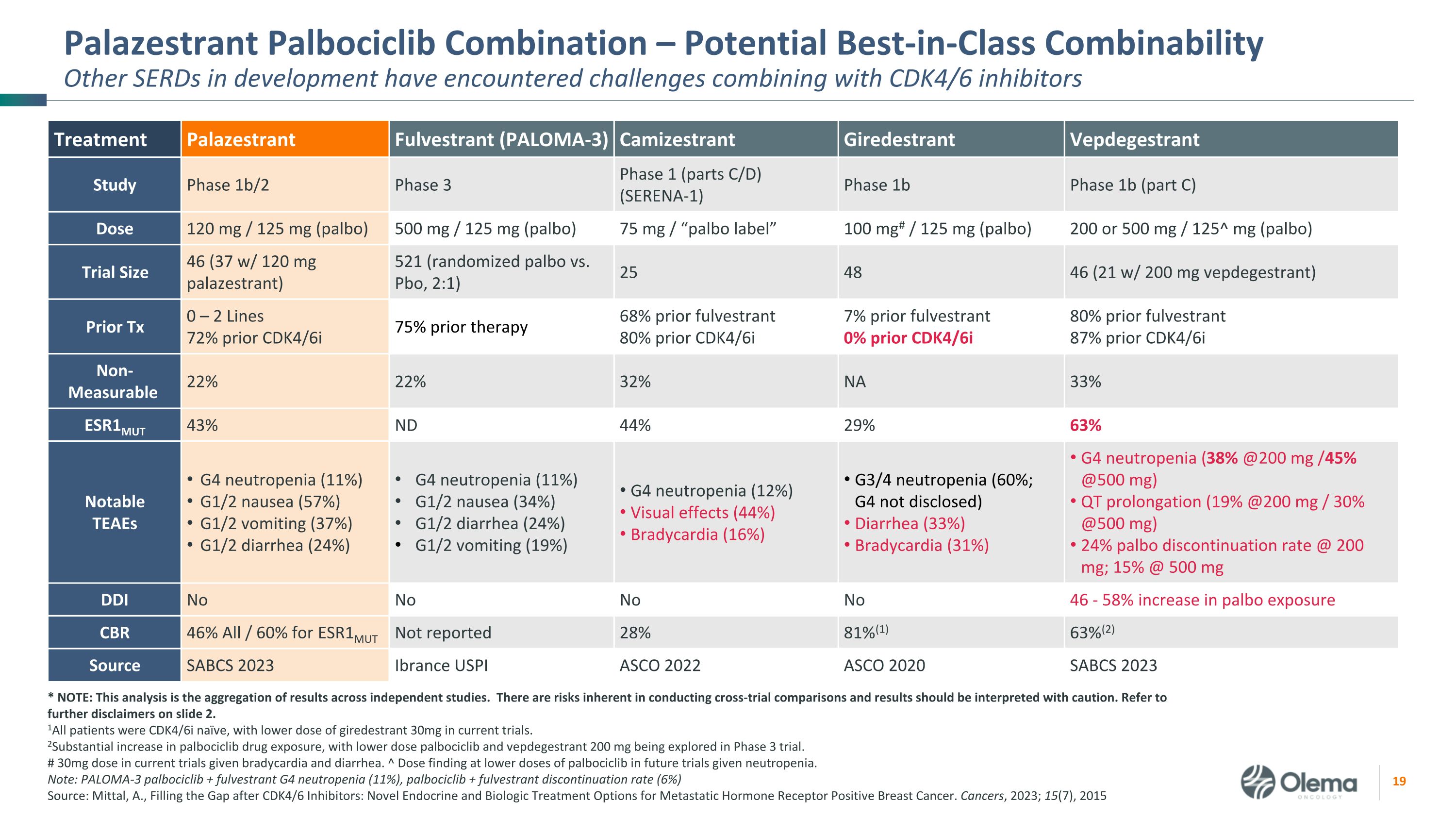
Palazestrant Palbociclib Combination – Potential Best-in-Class Combinability�Other SERDs in development have encountered challenges combining with CDK4/6 inhibitors * NOTE: This analysis is the aggregation of results across independent studies. There are risks inherent in conducting cross-trial comparisons and results should be interpreted with caution. Refer to further disclaimers on slide 2. 1All patients were CDK4/6i naïve, with lower dose of giredestrant 30mg in current trials. 2Substantial increase in palbociclib drug exposure, with lower dose palbociclib and vepdegestrant 200 mg being explored in Phase 3 trial. # 30mg dose in current trials given bradycardia and diarrhea. ^ Dose finding at lower doses of palbociclib in future trials given neutropenia. Note: PALOMA-3 palbociclib + fulvestrant G4 neutropenia (11%), palbociclib + fulvestrant discontinuation rate (6%) Source: Mittal, A., Filling the Gap after CDK4/6 Inhibitors: Novel Endocrine and Biologic Treatment Options for Metastatic Hormone Receptor Positive Breast Cancer. Cancers, 2023; 15(7), 2015 Treatment Palazestrant Fulvestrant (PALOMA-3) Camizestrant Giredestrant Vepdegestrant Study Phase 1b/2 Phase 3 Phase 1 (parts C/D)�(SERENA-1) Phase 1b Phase 1b (part C) Dose 120 mg / 125 mg (palbo) 500 mg / 125 mg (palbo) 75 mg / “palbo label” 100 mg# / 125 mg (palbo) 200 or 500 mg / 125^ mg (palbo) Trial Size 46 (37 w/ 120 mg palazestrant) 521 (randomized palbo vs. Pbo, 2:1) 25 48 46 (21 w/ 200 mg vepdegestrant) Prior Tx 0 – 2 Lines�72% prior CDK4/6i 75% prior therapy 68% prior fulvestrant�80% prior CDK4/6i 7% prior fulvestrant�0% prior CDK4/6i 80% prior fulvestrant 87% prior CDK4/6i Non-Measurable 22% 22% 32% NA 33% ESR1MUT 43% ND 44% 29% 63% Notable �TEAEs G4 neutropenia (11%) G1/2 nausea (57%) G1/2 vomiting (37%) G1/2 diarrhea (24%) G4 neutropenia (11%) G1/2 nausea (34%) G1/2 diarrhea (24%) G1/2 vomiting (19%) G4 neutropenia (12%) Visual effects (44%) Bradycardia (16%) G3/4 neutropenia (60%; G4 not disclosed) Diarrhea (33%) Bradycardia (31%) G4 neutropenia (38% @200 mg /45% @500 mg) QT prolongation (19% @200 mg / 30% @500 mg) 24% palbo discontinuation rate @ 200 mg; 15% @ 500 mg DDI No No No No 46 - 58% increase in palbo exposure CBR 46% All / 60% for ESR1MUT Not reported 28% 81%(1) 63%(2) Source SABCS 2023 Ibrance USPI ASCO 2022 ASCO 2020 SABCS 2023
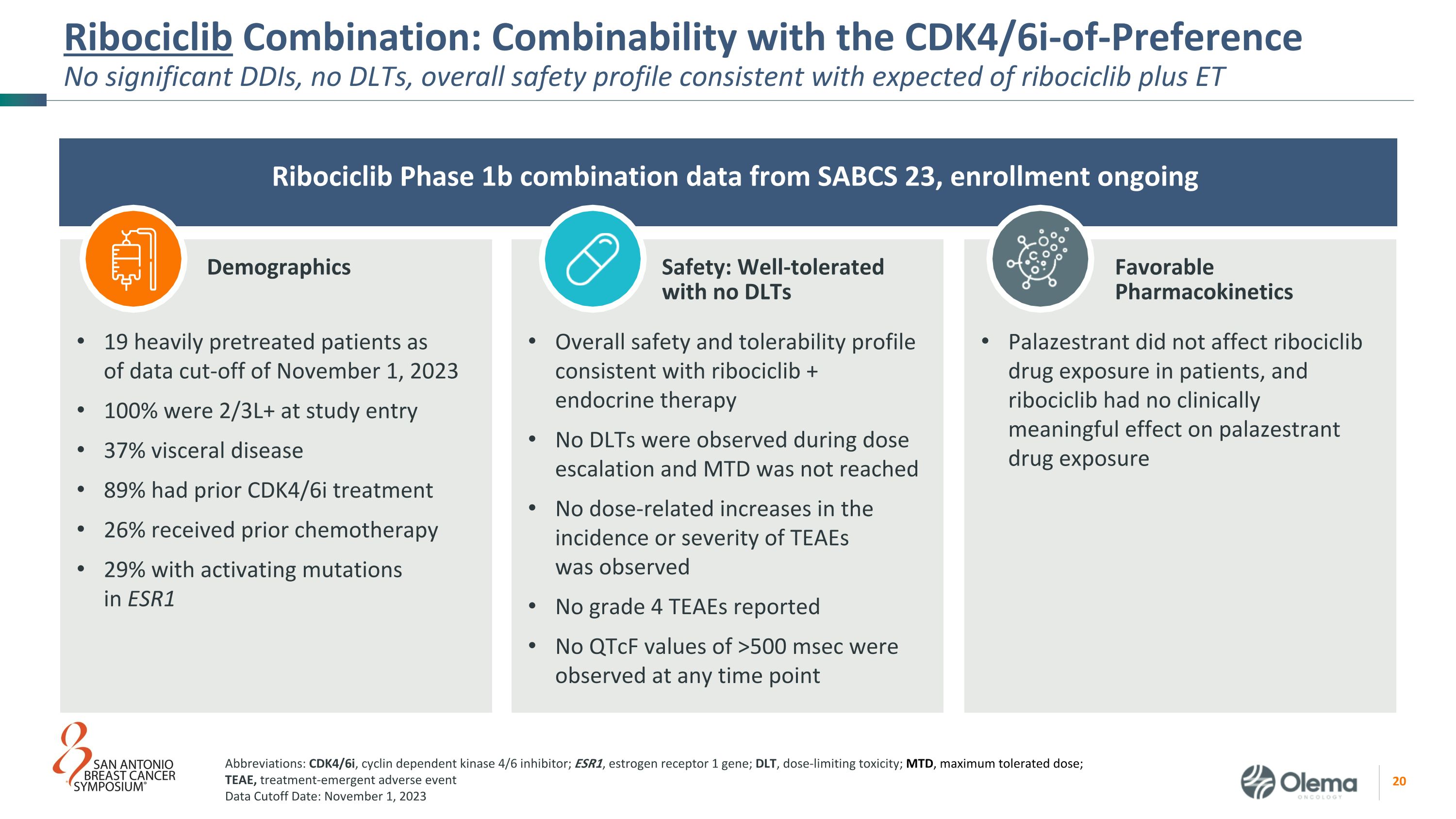
Ribociclib Combination: Combinability with the CDK4/6i-of-Preference�No significant DDIs, no DLTs, overall safety profile consistent with expected of ribociclib plus ET Ribociclib Phase 1b combination data from SABCS 23, enrollment ongoing Palazestrant did not affect ribociclib drug exposure in patients, and ribociclib had no clinically meaningful effect on palazestrant drug exposure 19 heavily pretreated patients as �of data cut-off of November 1, 2023 100% were 2/3L+ at study entry 37% visceral disease 89% had prior CDK4/6i treatment 26% received prior chemotherapy 29% with activating mutations �in ESR1 Overall safety and tolerability profile consistent with ribociclib + endocrine therapy No DLTs were observed during dose escalation and MTD was not reached No dose-related increases in the incidence or severity of TEAEs �was observed No grade 4 TEAEs reported No QTcF values of >500 msec were observed at any time point Abbreviations: CDK4/6i, cyclin dependent kinase 4/6 inhibitor; ESR1, estrogen receptor 1 gene; DLT, dose-limiting toxicity; MTD, maximum tolerated dose; TEAE, treatment-emergent adverse event Data Cutoff Date: November 1, 2023 Demographics Safety: Well-tolerated with no DLTs Favorable Pharmacokinetics
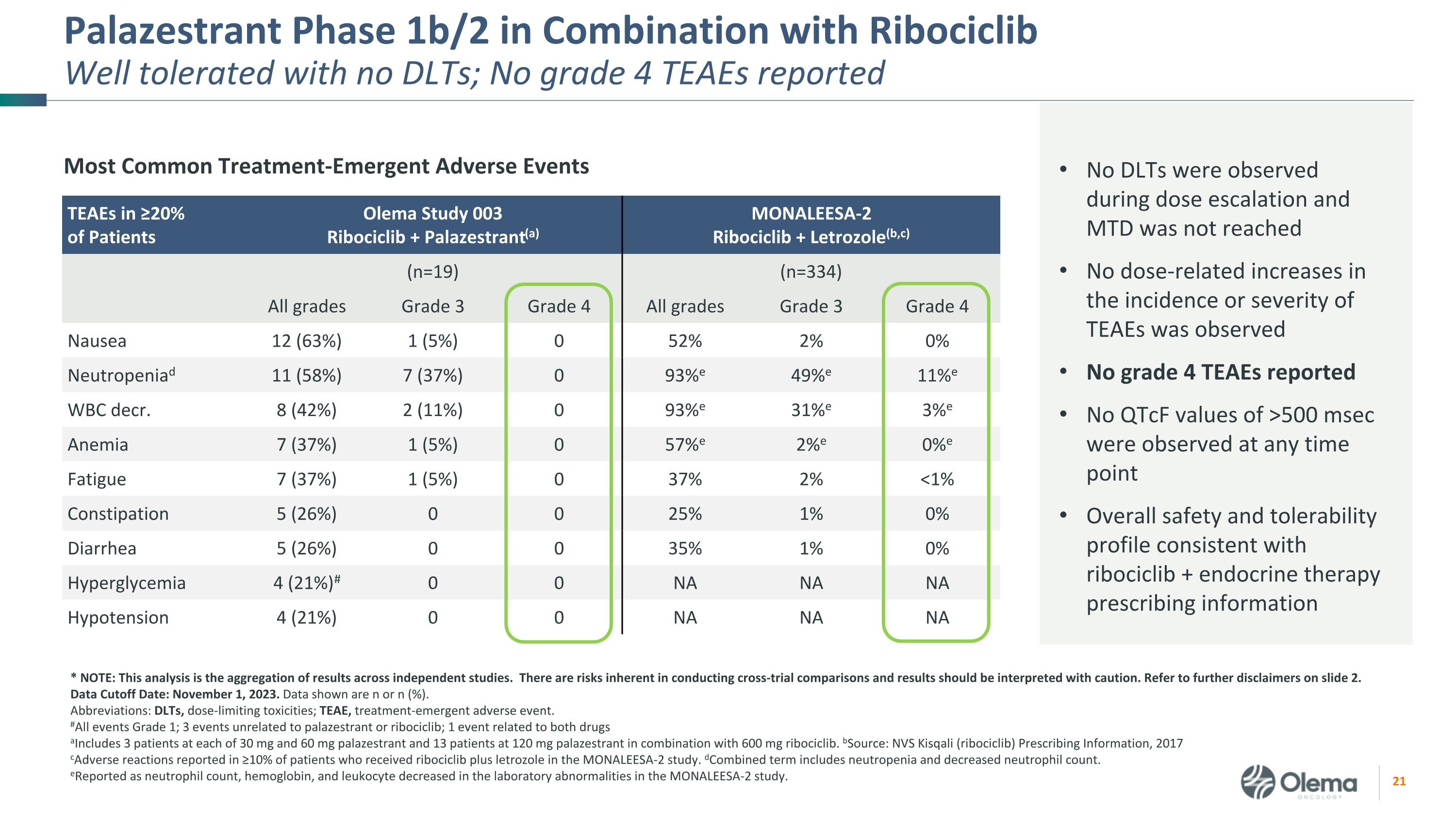
Palazestrant Phase 1b/2 in Combination with Ribociclib �Well tolerated with no DLTs; No grade 4 TEAEs reported Most Common Treatment-Emergent Adverse Events TEAEs in ≥20% �of Patients Olema Study 003�Ribociclib + Palazestrant(a) MONALEESA-2�Ribociclib + Letrozole(b,c) (n=19) (n=334) All grades Grade 3 Grade 4 All grades Grade 3 Grade 4 Nausea 12 (63%) 1 (5%) 0 52% 2% 0% Neutropeniad 11 (58%) 7 (37%) 0 93%e 49%e 11%e WBC decr. 8 (42%) 2 (11%) 0 93%e 31%e 3%e Anemia 7 (37%) 1 (5%) 0 57%e 2%e 0%e Fatigue 7 (37%) 1 (5%) 0 37% 2% <1% Constipation 5 (26%) 0 0 25% 1% 0% Diarrhea 5 (26%) 0 0 35% 1% 0% Hyperglycemia 4 (21%)# 0 0 NA NA NA Hypotension 4 (21%) 0 0 NA NA NA * NOTE: This analysis is the aggregation of results across independent studies. There are risks inherent in conducting cross-trial comparisons and results should be interpreted with caution. Refer to further disclaimers on slide 2. Data Cutoff Date: November 1, 2023. Data shown are n or n (%). Abbreviations: DLTs, dose-limiting toxicities; TEAE, treatment-emergent adverse event.�#All events Grade 1; 3 events unrelated to palazestrant or ribociclib; 1 event related to both drugs aIncludes 3 patients at each of 30 mg and 60 mg palazestrant and 13 patients at 120 mg palazestrant in combination with 600 mg ribociclib. bSource: NVS Kisqali (ribociclib) Prescribing Information, 2017 cAdverse reactions reported in ≥10% of patients who received ribociclib plus letrozole in the MONALEESA-2 study. dCombined term includes neutropenia and decreased neutrophil count. eReported as neutrophil count, hemoglobin, and leukocyte decreased in the laboratory abnormalities in the MONALEESA-2 study. No DLTs were observed during dose escalation and MTD was not reached No dose-related increases in the incidence or severity of TEAEs was observed No grade 4 TEAEs reported No QTcF values of >500 msec were observed at any time point Overall safety and tolerability profile consistent with ribociclib + endocrine therapy prescribing information
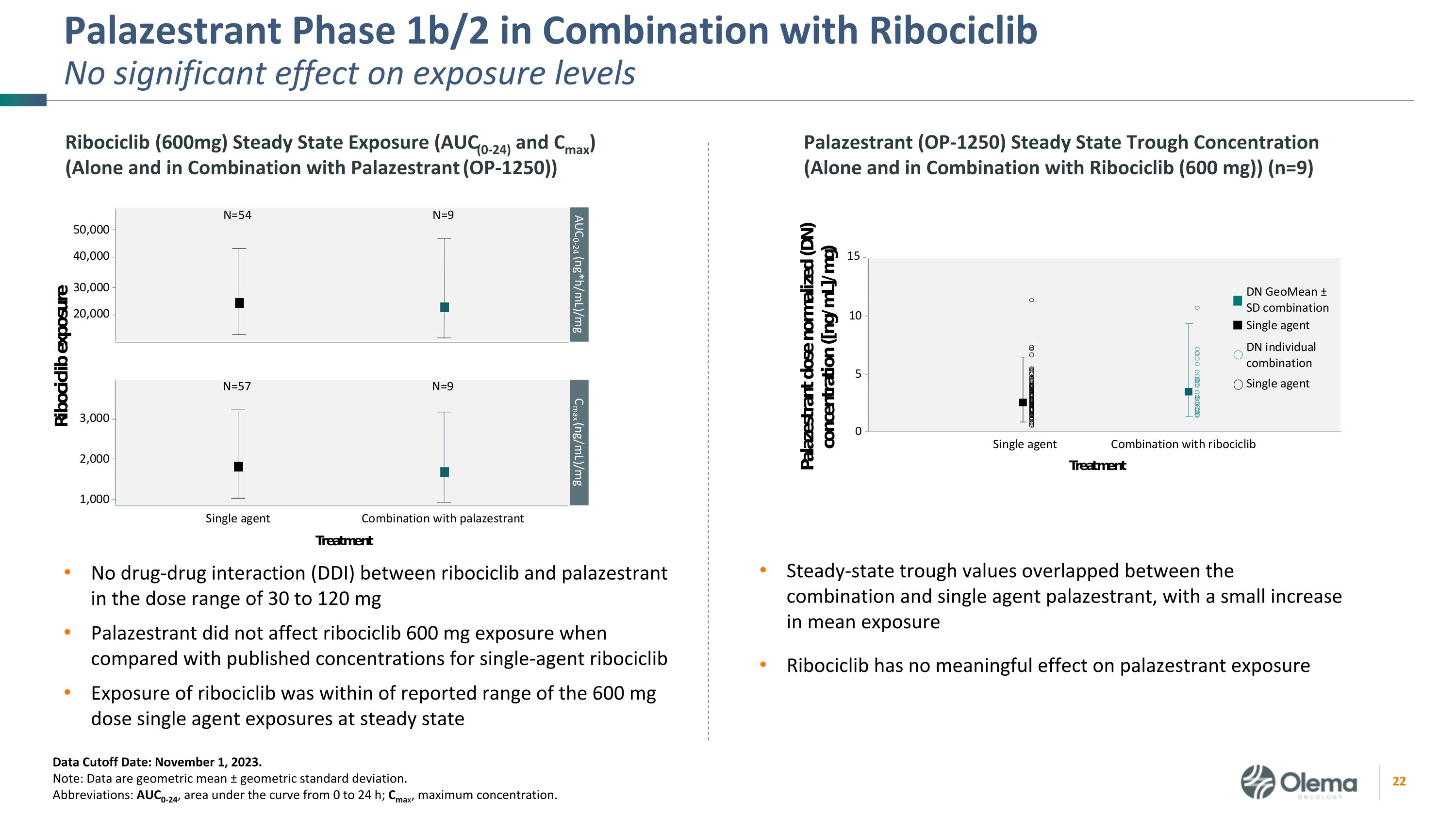
Palazestrant Phase 1b/2 in Combination with Ribociclib �No significant effect on exposure levels No drug-drug interaction (DDI) between ribociclib and palazestrant in the dose range of 30 to 120 mg Palazestrant did not affect ribociclib 600 mg exposure when compared with published concentrations for single-agent ribociclib Exposure of ribociclib was within of reported range of the 600 mg dose single agent exposures at steady state Data Cutoff Date: November 1, 2023. �Note: Data are geometric mean ± geometric standard deviation.�Abbreviations: AUC0-24, area under the curve from 0 to 24 h; Cmax, maximum concentration. Steady-state trough values overlapped between the combination and single agent palazestrant, with a small increase in mean exposure Ribociclib has no meaningful effect on palazestrant exposure Ribociclib (600mg) Steady State Exposure (AUC(0-24) and Cmax) �(Alone and in Combination with Palazestrant (OP-1250)) Palazestrant (OP-1250) Steady State Trough Concentration �(Alone and in Combination with Ribociclib (600 mg)) (n=9)
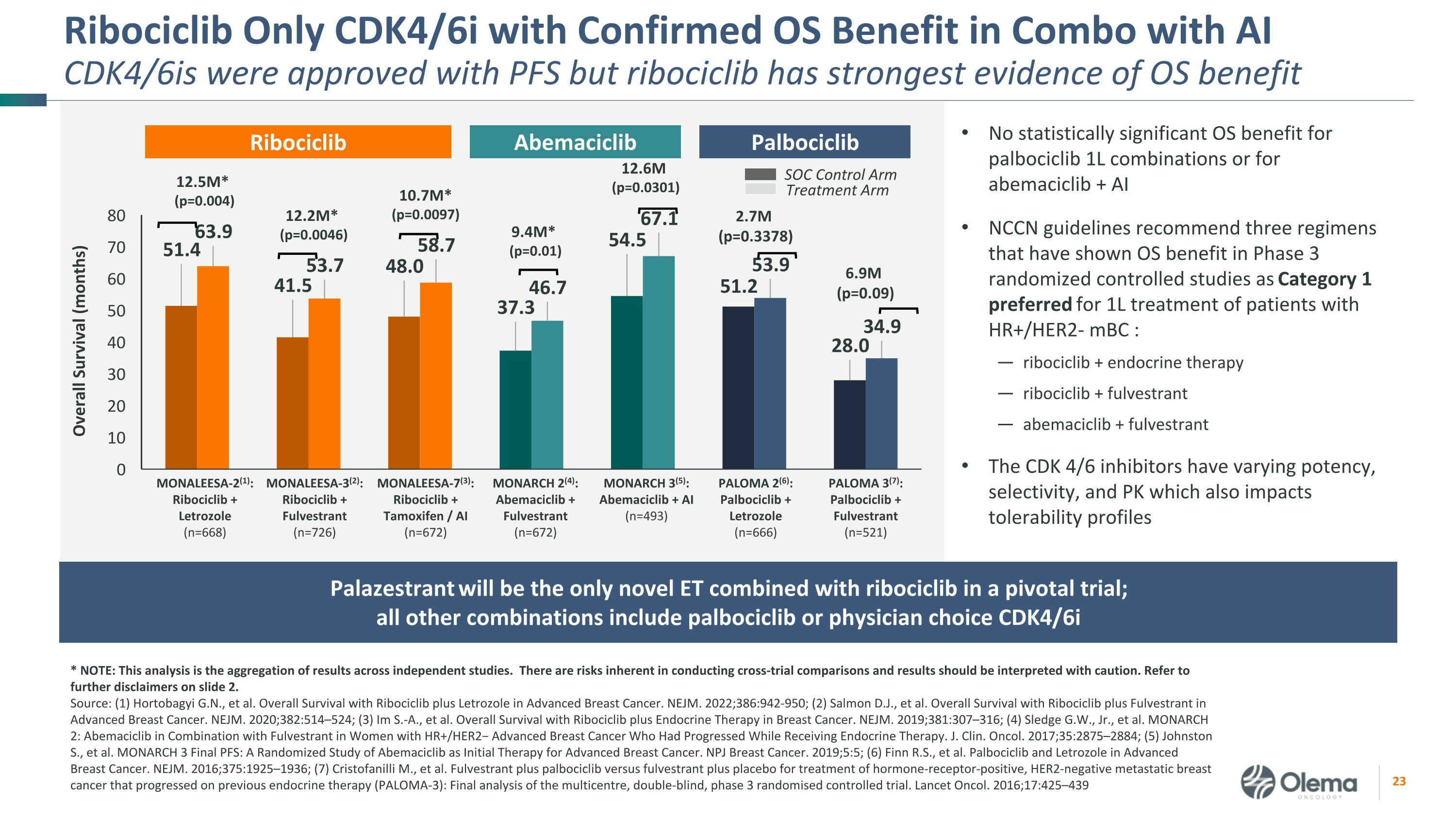
Ribociclib Only CDK4/6i with Confirmed OS Benefit in Combo with AI�CDK4/6is were approved with PFS but ribociclib has strongest evidence of OS benefit * NOTE: This analysis is the aggregation of results across independent studies. There are risks inherent in conducting cross-trial comparisons and results should be interpreted with caution. Refer to further disclaimers on slide 2. Source: (1) Hortobagyi G.N., et al. Overall Survival with Ribociclib plus Letrozole in Advanced Breast Cancer. NEJM. 2022;386:942-950; (2) Salmon D.J., et al. Overall Survival with Ribociclib plus Fulvestrant in Advanced Breast Cancer. NEJM. 2020;382:514–524; (3) Im S.-A., et al. Overall Survival with Ribociclib plus Endocrine Therapy in Breast Cancer. NEJM. 2019;381:307–316; (4) Sledge G.W., Jr., et al. MONARCH 2: Abemaciclib in Combination with Fulvestrant in Women with HR+/HER2− Advanced Breast Cancer Who Had Progressed While Receiving Endocrine Therapy. J. Clin. Oncol. 2017;35:2875–2884; (5) Johnston S., et al. MONARCH 3 Final PFS: A Randomized Study of Abemaciclib as Initial Therapy for Advanced Breast Cancer. NPJ Breast Cancer. 2019;5:5; (6) Finn R.S., et al. Palbociclib and Letrozole in Advanced Breast Cancer. NEJM. 2016;375:1925–1936; (7) Cristofanilli M., et al. Fulvestrant plus palbociclib versus fulvestrant plus placebo for treatment of hormone-receptor-positive, HER2-negative metastatic breast cancer that progressed on previous endocrine therapy (PALOMA-3): Final analysis of the multicentre, double-blind, phase 3 randomised controlled trial. Lancet Oncol. 2016;17:425–439 No statistically significant OS benefit for palbociclib 1L combinations or for abemaciclib + AI NCCN guidelines recommend three regimens that have shown OS benefit in Phase 3 randomized controlled studies as Category 1 preferred for 1L treatment of patients with HR+/HER2- mBC : ribociclib + endocrine therapy ribociclib + fulvestrant abemaciclib + fulvestrant The CDK 4/6 inhibitors have varying potency, selectivity, and PK which also impacts tolerability profiles Ribociclib MONARCH 2(4): �Abemaciclib + Fulvestrant�(n=672) MONARCH 3(5): �Abemaciclib + AI�(n=493) MONALEESA-2(1): �Ribociclib + Letrozole�(n=668) MONALEESA-3(2): �Ribociclib + Fulvestrant�(n=726) PALOMA 2(6): �Palbociclib + Letrozole�(n=666) PALOMA 3(7): �Palbociclib + Fulvestrant�(n=521) MONALEESA-7(3): �Ribociclib + Tamoxifen / AI�(n=672) 9.4M* �(p=0.01) SOC Control Arm Treatment Arm 12.5M* �(p=0.004) 12.2M* �(p=0.0046) 10.7M* �(p=0.0097) 12.6M �(p=0.0301) 2.7M �(p=0.3378) 6.9M �(p=0.09) Abemaciclib Palbociclib Palazestrant will be the only novel ET combined with ribociclib in a pivotal trial; �all other combinations include palbociclib or physician choice CDK4/6i

Advancing in �Pivotal Phase 3 Trials
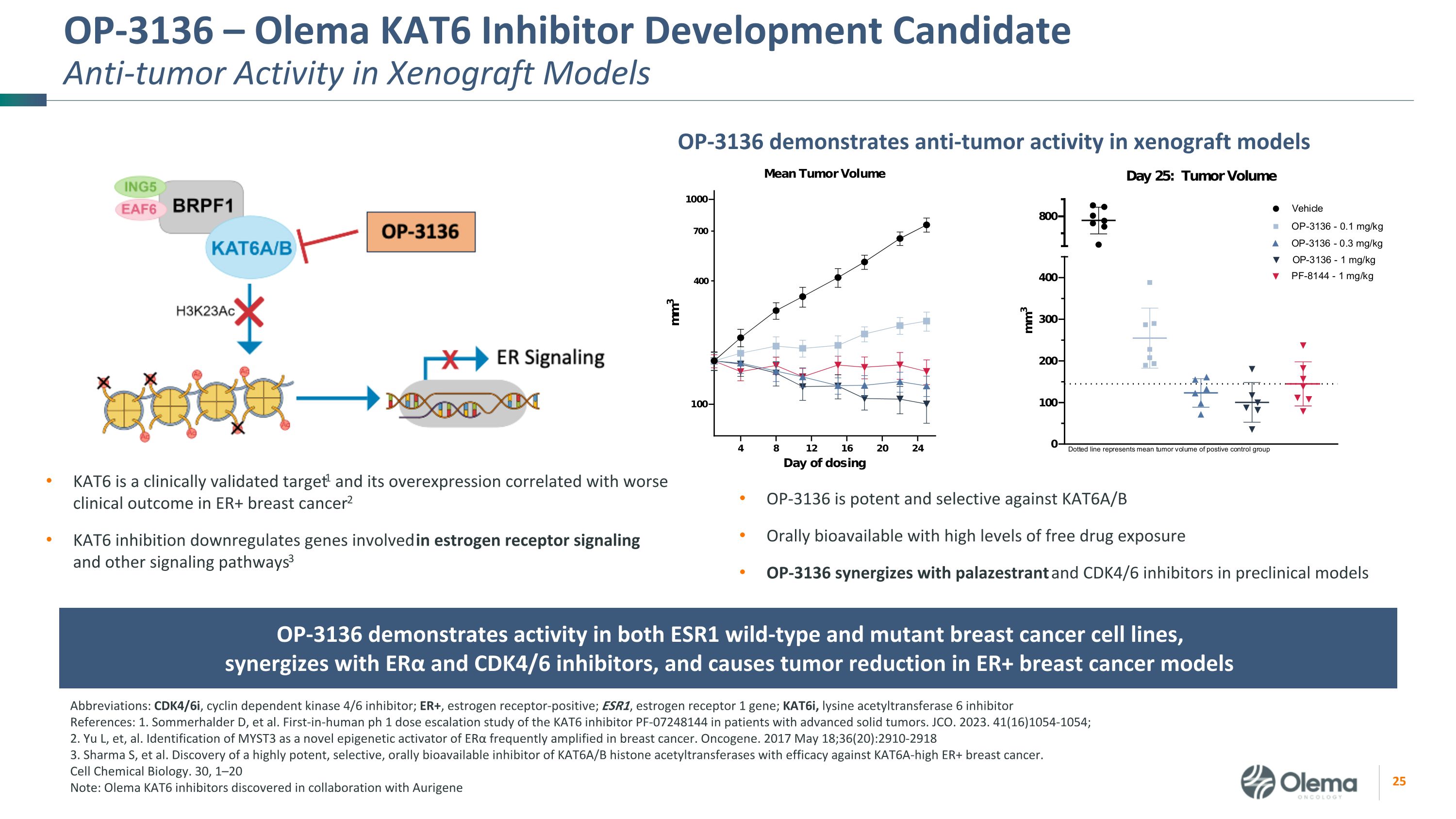
OP-3136 – Olema KAT6 Inhibitor Development Candidate Anti-tumor Activity in Xenograft Models OP-3136 demonstrates anti-tumor activity in xenograft models KAT6 is a clinically validated target1 and its overexpression correlated with worse clinical outcome in ER+ breast cancer2 KAT6 inhibition downregulates genes involved in estrogen receptor signaling and other signaling pathways3 Abbreviations: CDK4/6i, cyclin dependent kinase 4/6 inhibitor; ER+, estrogen receptor-positive; ESR1, estrogen receptor 1 gene; KAT6i, lysine acetyltransferase 6 inhibitor References: 1. Sommerhalder D, et al. First-in-human ph 1 dose escalation study of the KAT6 inhibitor PF-07248144 in patients with advanced solid tumors. JCO. 2023. 41(16)1054-1054; �2. Yu L, et, al. Identification of MYST3 as a novel epigenetic activator of ERα frequently amplified in breast cancer. Oncogene. 2017 May 18;36(20):2910-2918 3. Sharma S, et al. Discovery of a highly potent, selective, orally bioavailable inhibitor of KAT6A/B histone acetyltransferases with efficacy against KAT6A-high ER+ breast cancer. �Cell Chemical Biology. 30, 1–20 Note: Olema KAT6 inhibitors discovered in collaboration with Aurigene OP-3136 is potent and selective against KAT6A/B Orally bioavailable with high levels of free drug exposure OP-3136 synergizes with palazestrant and CDK4/6 inhibitors in preclinical models OP-3136 demonstrates activity in both ESR1 wild-type and mutant breast cancer cell lines, �synergizes with ERα and CDK4/6 inhibitors, and causes tumor reduction in ER+ breast cancer models
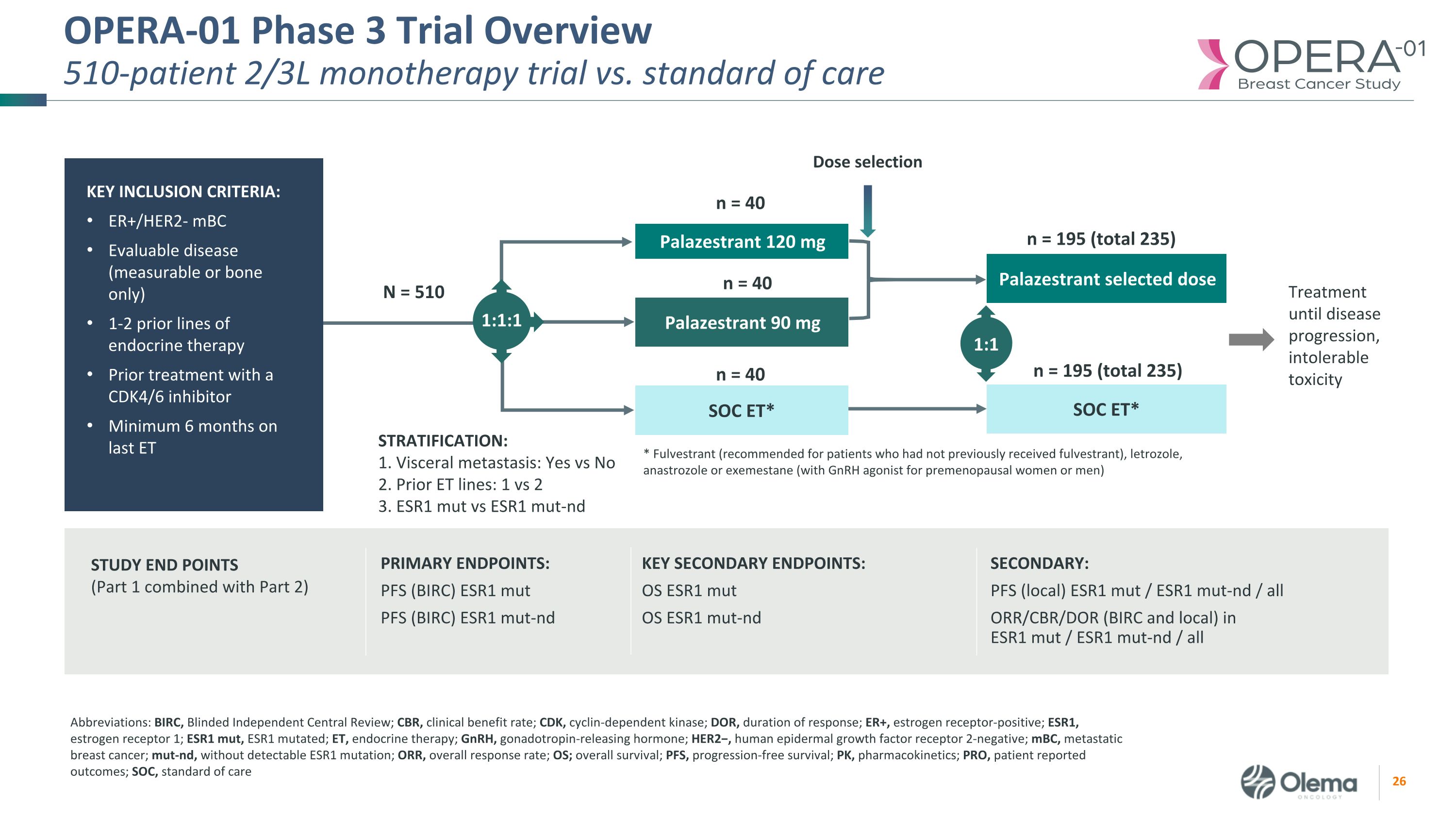
OPERA-01 Phase 3 Trial Overview�510-patient 2/3L monotherapy trial vs. standard of care PRIMARY ENDPOINTS: PFS (BIRC) ESR1 mut PFS (BIRC) ESR1 mut-nd SECONDARY: PFS (local) ESR1 mut / ESR1 mut-nd / all ORR/CBR/DOR (BIRC and local) in �ESR1 mut / ESR1 mut-nd / all STUDY END POINTS (Part 1 combined with Part 2) KEY SECONDARY ENDPOINTS: OS ESR1 mut OS ESR1 mut-nd Palazestrant 120 mg SOC ET* * Fulvestrant (recommended for patients who had not previously received fulvestrant), letrozole, anastrozole or exemestane (with GnRH agonist for premenopausal women or men) STRATIFICATION: 1. Visceral metastasis: Yes vs No 2. Prior ET lines: 1 vs 2 3. ESR1 mut vs ESR1 mut-nd Palazestrant 90 mg N = 510 Palazestrant selected dose Dose selection 1:1 1:1:1 n = 40 n = 40 Treatment until disease progression, intolerable toxicity SOC ET* n = 40 n = 195 (total 235) n = 195 (total 235) Abbreviations: BIRC, Blinded Independent Central Review; CBR, clinical benefit rate; CDK, cyclin-dependent kinase; DOR, duration of response; ER+, estrogen receptor-positive; ESR1, estrogen receptor 1; ESR1 mut, ESR1 mutated; ET, endocrine therapy; GnRH, gonadotropin-releasing hormone; HER2−, human epidermal growth factor receptor 2-negative; mBC, metastatic breast cancer; mut-nd, without detectable ESR1 mutation; ORR, overall response rate; OS; overall survival; PFS, progression-free survival; PK, pharmacokinetics; PRO, patient reported outcomes; SOC, standard of care KEY INCLUSION CRITERIA: ER+/HER2- mBC Evaluable disease (measurable or bone only) 1-2 prior lines of endocrine therapy Prior treatment with a CDK4/6 inhibitor Minimum 6 months on last ET
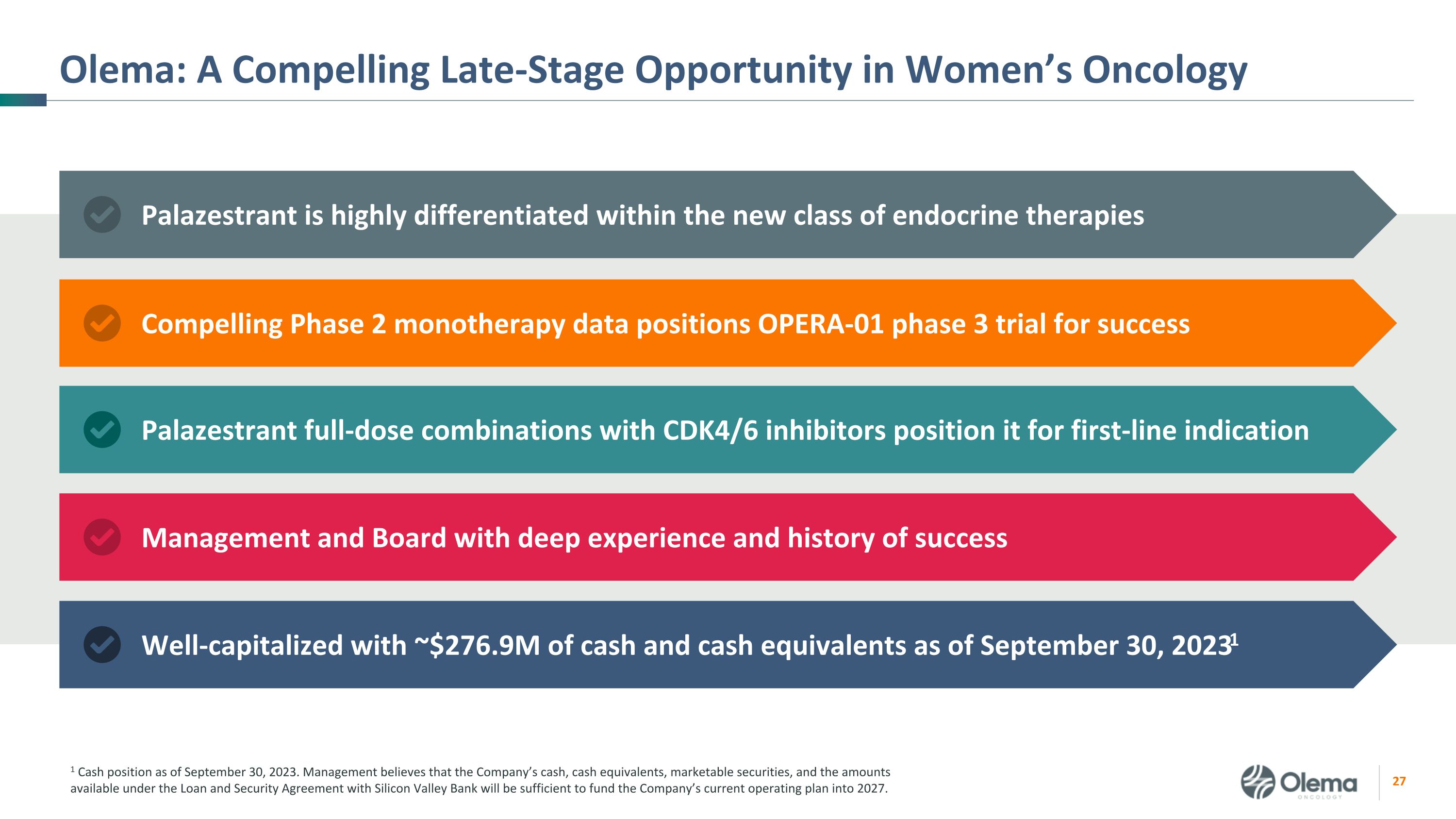
Olema: A Compelling Late-Stage Opportunity in Women’s Oncology Well-capitalized with ~$276.9M of cash and cash equivalents as of September 30, 20231 Palazestrant full-dose combinations with CDK4/6 inhibitors position it for first-line indication Palazestrant is highly differentiated within the new class of endocrine therapies 1 Cash position as of September 30, 2023. Management believes that the Company’s cash, cash equivalents, marketable securities, and the amounts �available under the Loan and Security Agreement with Silicon Valley Bank will be sufficient to fund the Company’s current operating plan into 2027. Compelling Phase 2 monotherapy data positions OPERA-01 phase 3 trial for success Management and Board with deep experience and history of success

v3.23.4
Document And Entity Information
|
Jan. 08, 2024 |
| Cover [Abstract] |
|
| Document Type |
8-K
|
| Amendment Flag |
false
|
| Document Period End Date |
Jan. 08, 2024
|
| Entity Registrant Name |
Olema Pharmaceuticals, Inc.
|
| Entity Central Index Key |
0001750284
|
| Entity Emerging Growth Company |
false
|
| Entity File Number |
001-39712
|
| Entity Incorporation, State or Country Code |
DE
|
| Entity Tax Identification Number |
30-0409740
|
| Entity Address, Address Line One |
780 Brannan Street
|
| Entity Address, City or Town |
San Francisco
|
| Entity Address, State or Province |
CA
|
| Entity Address, Postal Zip Code |
94103
|
| City Area Code |
415
|
| Local Phone Number |
651-3316
|
| Entity Information, Former Legal or Registered Name |
N/A
|
| Written Communications |
false
|
| Soliciting Material |
false
|
| Pre-commencement Tender Offer |
false
|
| Pre-commencement Issuer Tender Offer |
false
|
| Title of 12(b) Security |
Common Stock, par value $0.0001 per share
|
| Trading Symbol |
OLMA
|
| Security Exchange Name |
NASDAQ
|
| X |
- DefinitionBoolean flag that is true when the XBRL content amends previously-filed or accepted submission.
| Name: |
dei_AmendmentFlag |
| Namespace Prefix: |
dei_ |
| Data Type: |
xbrli:booleanItemType |
| Balance Type: |
na |
| Period Type: |
duration |
|
| X |
- DefinitionFor the EDGAR submission types of Form 8-K: the date of the report, the date of the earliest event reported; for the EDGAR submission types of Form N-1A: the filing date; for all other submission types: the end of the reporting or transition period. The format of the date is YYYY-MM-DD.
| Name: |
dei_DocumentPeriodEndDate |
| Namespace Prefix: |
dei_ |
| Data Type: |
xbrli:dateItemType |
| Balance Type: |
na |
| Period Type: |
duration |
|
| X |
- DefinitionThe type of document being provided (such as 10-K, 10-Q, 485BPOS, etc). The document type is limited to the same value as the supporting SEC submission type, or the word 'Other'.
| Name: |
dei_DocumentType |
| Namespace Prefix: |
dei_ |
| Data Type: |
dei:submissionTypeItemType |
| Balance Type: |
na |
| Period Type: |
duration |
|
| X |
- DefinitionAddress Line 1 such as Attn, Building Name, Street Name
| Name: |
dei_EntityAddressAddressLine1 |
| Namespace Prefix: |
dei_ |
| Data Type: |
xbrli:normalizedStringItemType |
| Balance Type: |
na |
| Period Type: |
duration |
|
| X |
- Definition
+ References
+ Details
| Name: |
dei_EntityAddressCityOrTown |
| Namespace Prefix: |
dei_ |
| Data Type: |
xbrli:normalizedStringItemType |
| Balance Type: |
na |
| Period Type: |
duration |
|
| X |
- DefinitionCode for the postal or zip code
| Name: |
dei_EntityAddressPostalZipCode |
| Namespace Prefix: |
dei_ |
| Data Type: |
xbrli:normalizedStringItemType |
| Balance Type: |
na |
| Period Type: |
duration |
|
| X |
- DefinitionName of the state or province.
| Name: |
dei_EntityAddressStateOrProvince |
| Namespace Prefix: |
dei_ |
| Data Type: |
dei:stateOrProvinceItemType |
| Balance Type: |
na |
| Period Type: |
duration |
|
| X |
- DefinitionA unique 10-digit SEC-issued value to identify entities that have filed disclosures with the SEC. It is commonly abbreviated as CIK. Reference 1: http://www.xbrl.org/2003/role/presentationRef
-Publisher SEC
-Name Exchange Act
-Number 240
-Section 12
-Subsection b-2
| Name: |
dei_EntityCentralIndexKey |
| Namespace Prefix: |
dei_ |
| Data Type: |
dei:centralIndexKeyItemType |
| Balance Type: |
na |
| Period Type: |
duration |
|
| X |
- DefinitionIndicate if registrant meets the emerging growth company criteria. Reference 1: http://www.xbrl.org/2003/role/presentationRef
-Publisher SEC
-Name Exchange Act
-Number 240
-Section 12
-Subsection b-2
| Name: |
dei_EntityEmergingGrowthCompany |
| Namespace Prefix: |
dei_ |
| Data Type: |
xbrli:booleanItemType |
| Balance Type: |
na |
| Period Type: |
duration |
|
| X |
- DefinitionCommission file number. The field allows up to 17 characters. The prefix may contain 1-3 digits, the sequence number may contain 1-8 digits, the optional suffix may contain 1-4 characters, and the fields are separated with a hyphen.
| Name: |
dei_EntityFileNumber |
| Namespace Prefix: |
dei_ |
| Data Type: |
dei:fileNumberItemType |
| Balance Type: |
na |
| Period Type: |
duration |
|
| X |
- DefinitionTwo-character EDGAR code representing the state or country of incorporation.
| Name: |
dei_EntityIncorporationStateCountryCode |
| Namespace Prefix: |
dei_ |
| Data Type: |
dei:edgarStateCountryItemType |
| Balance Type: |
na |
| Period Type: |
duration |
|
| X |
- DefinitionThe exact name of the entity filing the report as specified in its charter, which is required by forms filed with the SEC. Reference 1: http://www.xbrl.org/2003/role/presentationRef
-Publisher SEC
-Name Exchange Act
-Number 240
-Section 12
-Subsection b-2
| Name: |
dei_EntityRegistrantName |
| Namespace Prefix: |
dei_ |
| Data Type: |
xbrli:normalizedStringItemType |
| Balance Type: |
na |
| Period Type: |
duration |
|
| X |
- DefinitionThe Tax Identification Number (TIN), also known as an Employer Identification Number (EIN), is a unique 9-digit value assigned by the IRS. Reference 1: http://www.xbrl.org/2003/role/presentationRef
-Publisher SEC
-Name Exchange Act
-Number 240
-Section 12
-Subsection b-2
| Name: |
dei_EntityTaxIdentificationNumber |
| Namespace Prefix: |
dei_ |
| Data Type: |
dei:employerIdItemType |
| Balance Type: |
na |
| Period Type: |
duration |
|
| X |
- DefinitionLocal phone number for entity.
| Name: |
dei_LocalPhoneNumber |
| Namespace Prefix: |
dei_ |
| Data Type: |
xbrli:normalizedStringItemType |
| Balance Type: |
na |
| Period Type: |
duration |
|
| X |
- DefinitionBoolean flag that is true when the Form 8-K filing is intended to satisfy the filing obligation of the registrant as pre-commencement communications pursuant to Rule 13e-4(c) under the Exchange Act. Reference 1: http://www.xbrl.org/2003/role/presentationRef
-Publisher SEC
-Name Exchange Act
-Number 240
-Section 13e
-Subsection 4c
| Name: |
dei_PreCommencementIssuerTenderOffer |
| Namespace Prefix: |
dei_ |
| Data Type: |
xbrli:booleanItemType |
| Balance Type: |
na |
| Period Type: |
duration |
|
| X |
- DefinitionBoolean flag that is true when the Form 8-K filing is intended to satisfy the filing obligation of the registrant as pre-commencement communications pursuant to Rule 14d-2(b) under the Exchange Act. Reference 1: http://www.xbrl.org/2003/role/presentationRef
-Publisher SEC
-Name Exchange Act
-Number 240
-Section 14d
-Subsection 2b
| Name: |
dei_PreCommencementTenderOffer |
| Namespace Prefix: |
dei_ |
| Data Type: |
xbrli:booleanItemType |
| Balance Type: |
na |
| Period Type: |
duration |
|
| X |
- DefinitionTitle of a 12(b) registered security. Reference 1: http://www.xbrl.org/2003/role/presentationRef
-Publisher SEC
-Name Exchange Act
-Number 240
-Section 12
-Subsection b
| Name: |
dei_Security12bTitle |
| Namespace Prefix: |
dei_ |
| Data Type: |
dei:securityTitleItemType |
| Balance Type: |
na |
| Period Type: |
duration |
|
| X |
- DefinitionName of the Exchange on which a security is registered. Reference 1: http://www.xbrl.org/2003/role/presentationRef
-Publisher SEC
-Name Exchange Act
-Number 240
-Section 12
-Subsection d1-1
| Name: |
dei_SecurityExchangeName |
| Namespace Prefix: |
dei_ |
| Data Type: |
dei:edgarExchangeCodeItemType |
| Balance Type: |
na |
| Period Type: |
duration |
|
| X |
- DefinitionBoolean flag that is true when the Form 8-K filing is intended to satisfy the filing obligation of the registrant as soliciting material pursuant to Rule 14a-12 under the Exchange Act. Reference 1: http://www.xbrl.org/2003/role/presentationRef
-Publisher SEC
-Name Exchange Act
-Section 14a
-Number 240
-Subsection 12
| Name: |
dei_SolicitingMaterial |
| Namespace Prefix: |
dei_ |
| Data Type: |
xbrli:booleanItemType |
| Balance Type: |
na |
| Period Type: |
duration |
|
| X |
- DefinitionTrading symbol of an instrument as listed on an exchange.
| Name: |
dei_TradingSymbol |
| Namespace Prefix: |
dei_ |
| Data Type: |
dei:tradingSymbolItemType |
| Balance Type: |
na |
| Period Type: |
duration |
|
| X |
- DefinitionBoolean flag that is true when the Form 8-K filing is intended to satisfy the filing obligation of the registrant as written communications pursuant to Rule 425 under the Securities Act. Reference 1: http://www.xbrl.org/2003/role/presentationRef
-Publisher SEC
-Name Securities Act
-Number 230
-Section 425
| Name: |
dei_WrittenCommunications |
| Namespace Prefix: |
dei_ |
| Data Type: |
xbrli:booleanItemType |
| Balance Type: |
na |
| Period Type: |
duration |
|
Olema Pharmaceuticals (NASDAQ:OLMA)
Historical Stock Chart
From Jun 2024 to Jul 2024

Olema Pharmaceuticals (NASDAQ:OLMA)
Historical Stock Chart
From Jul 2023 to Jul 2024
